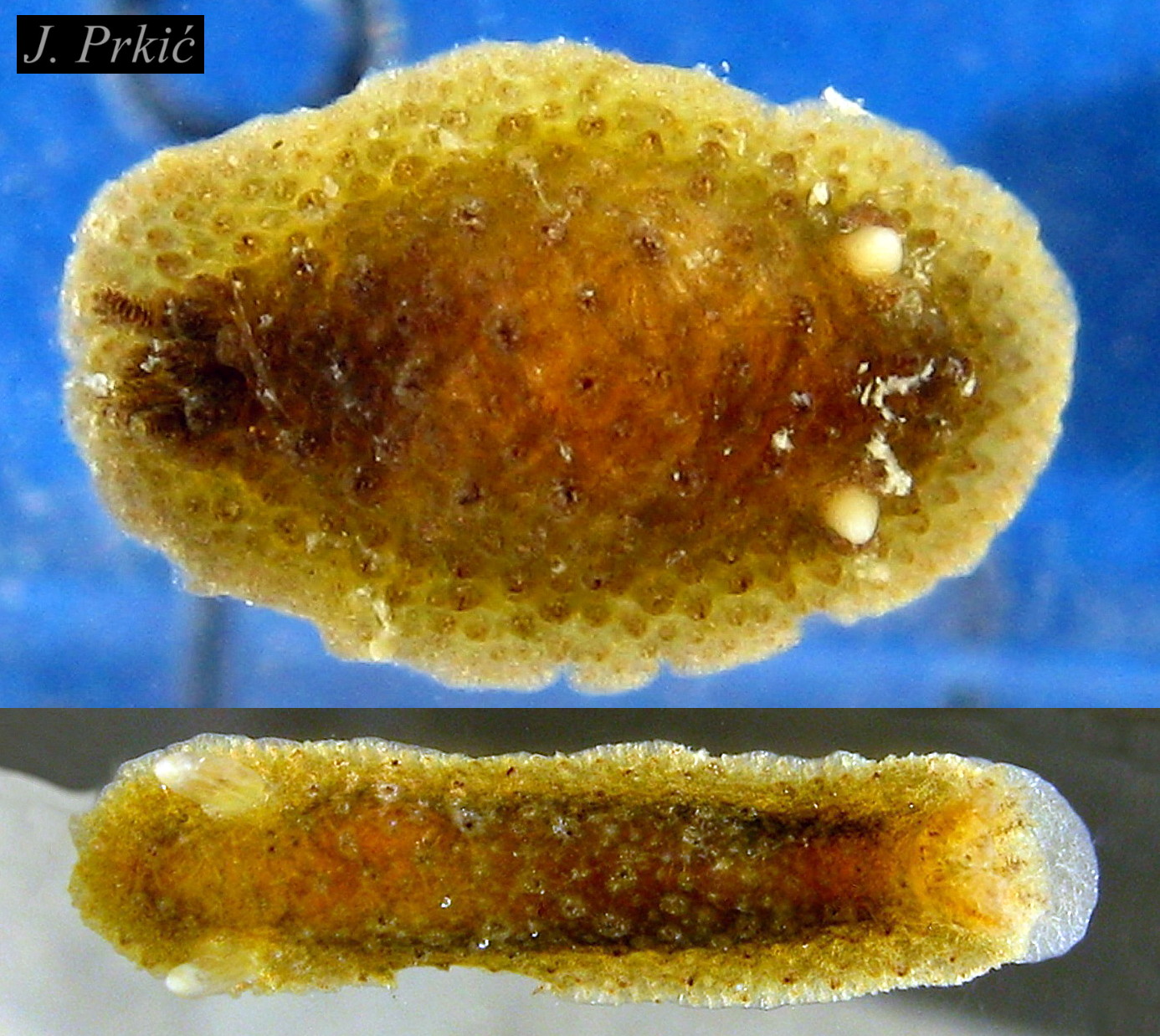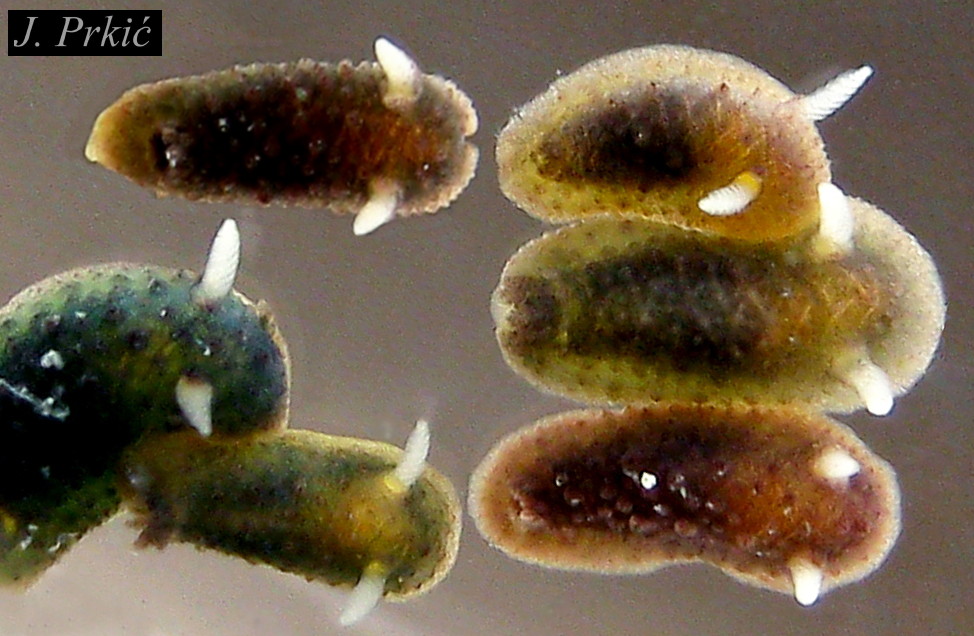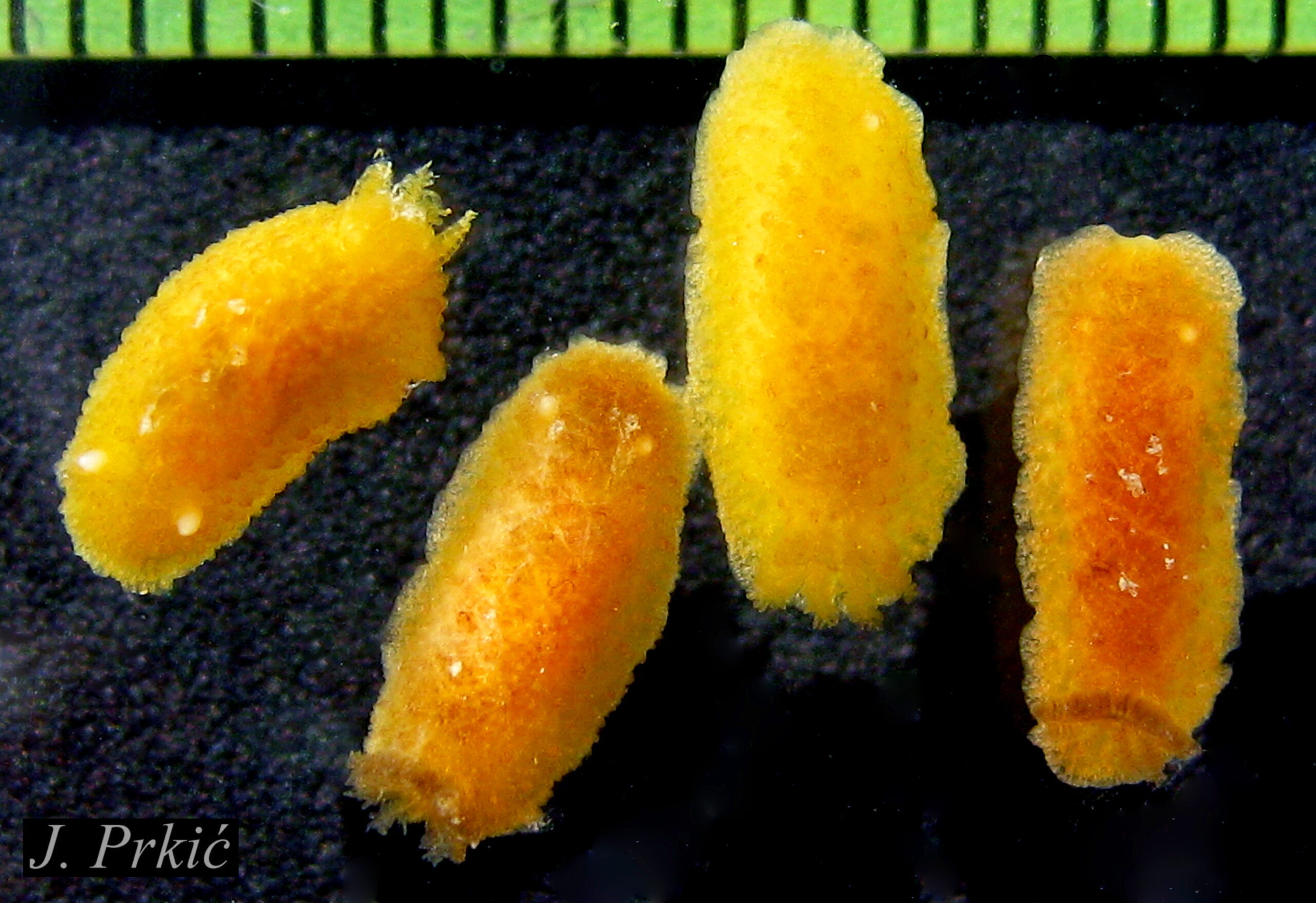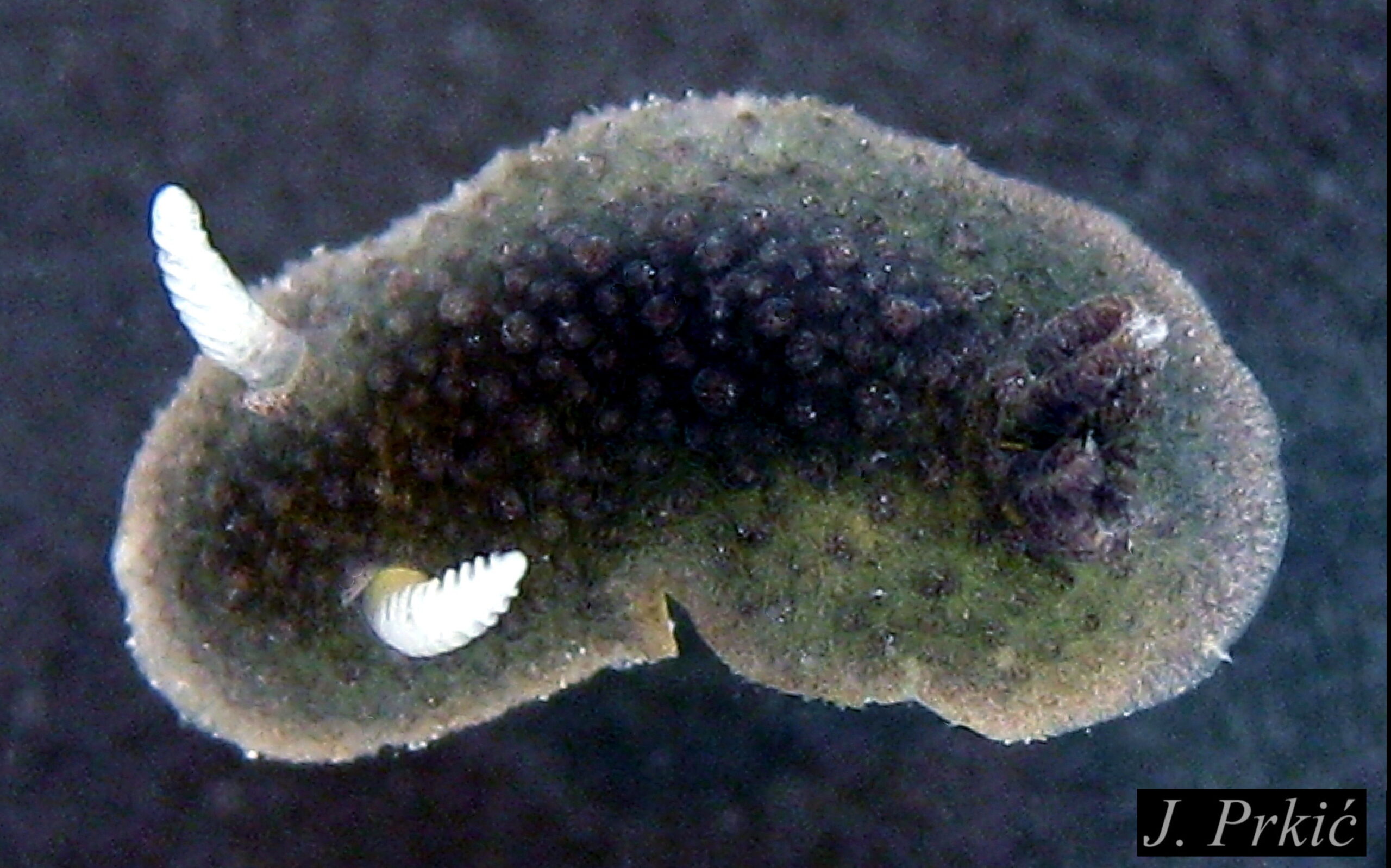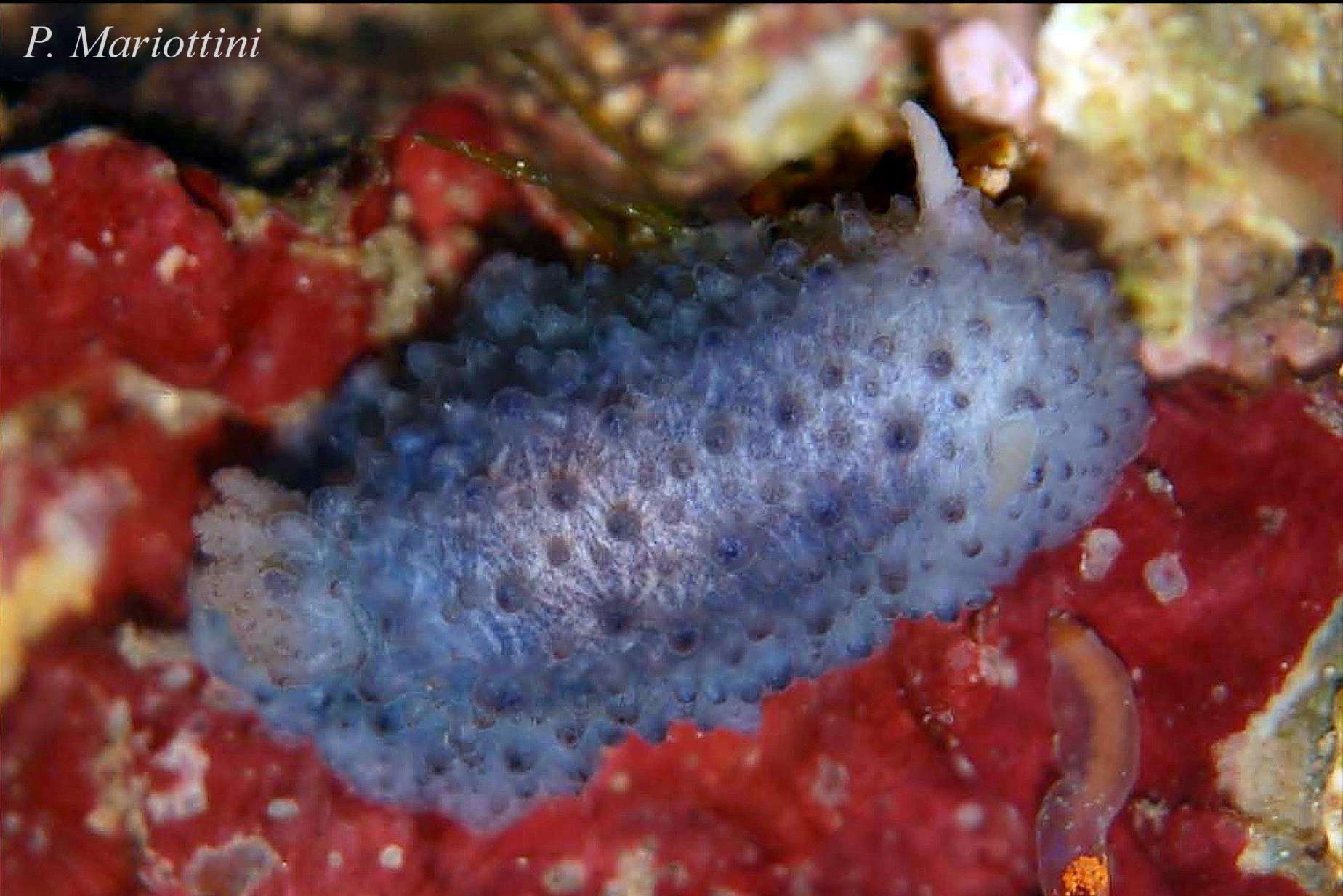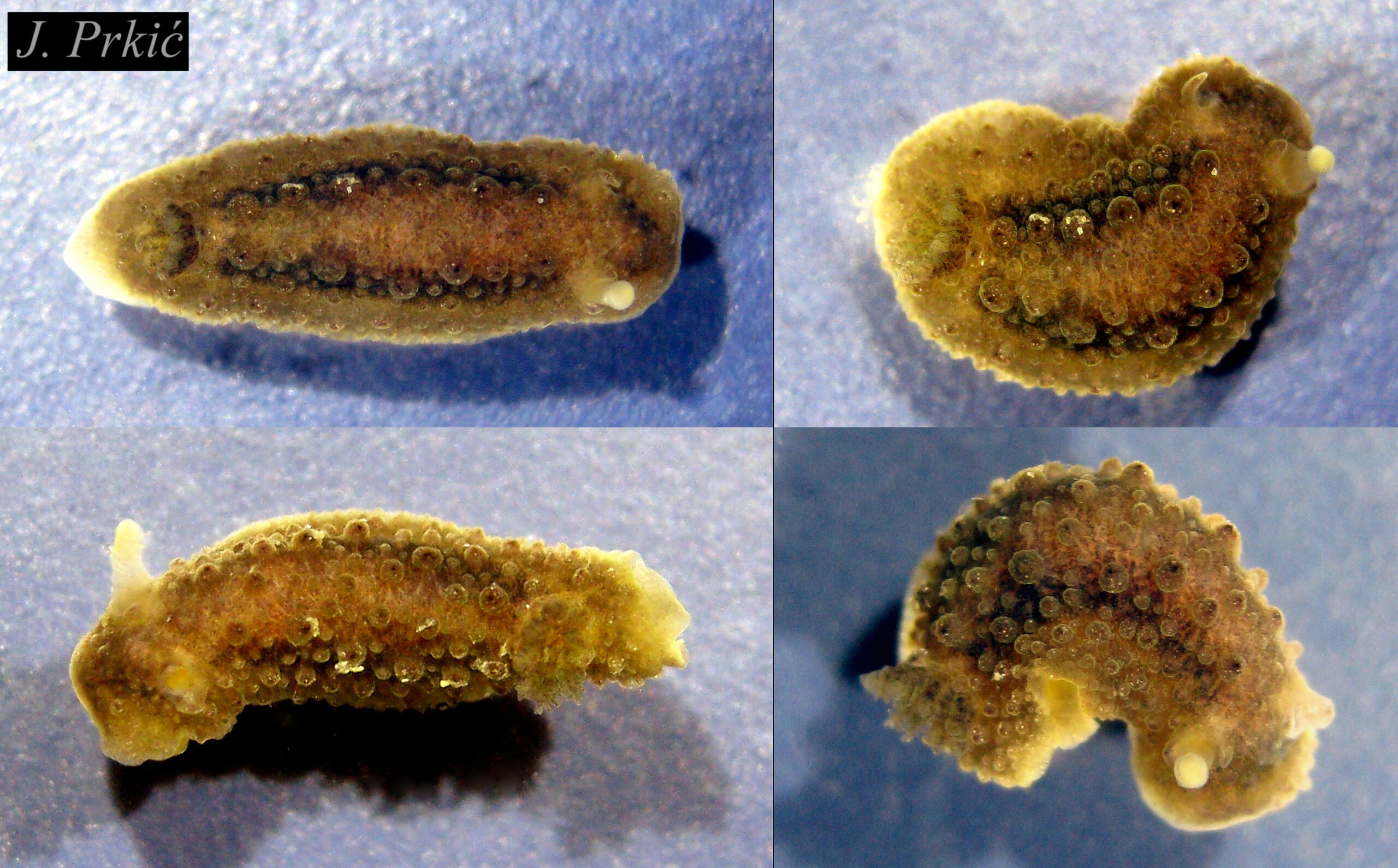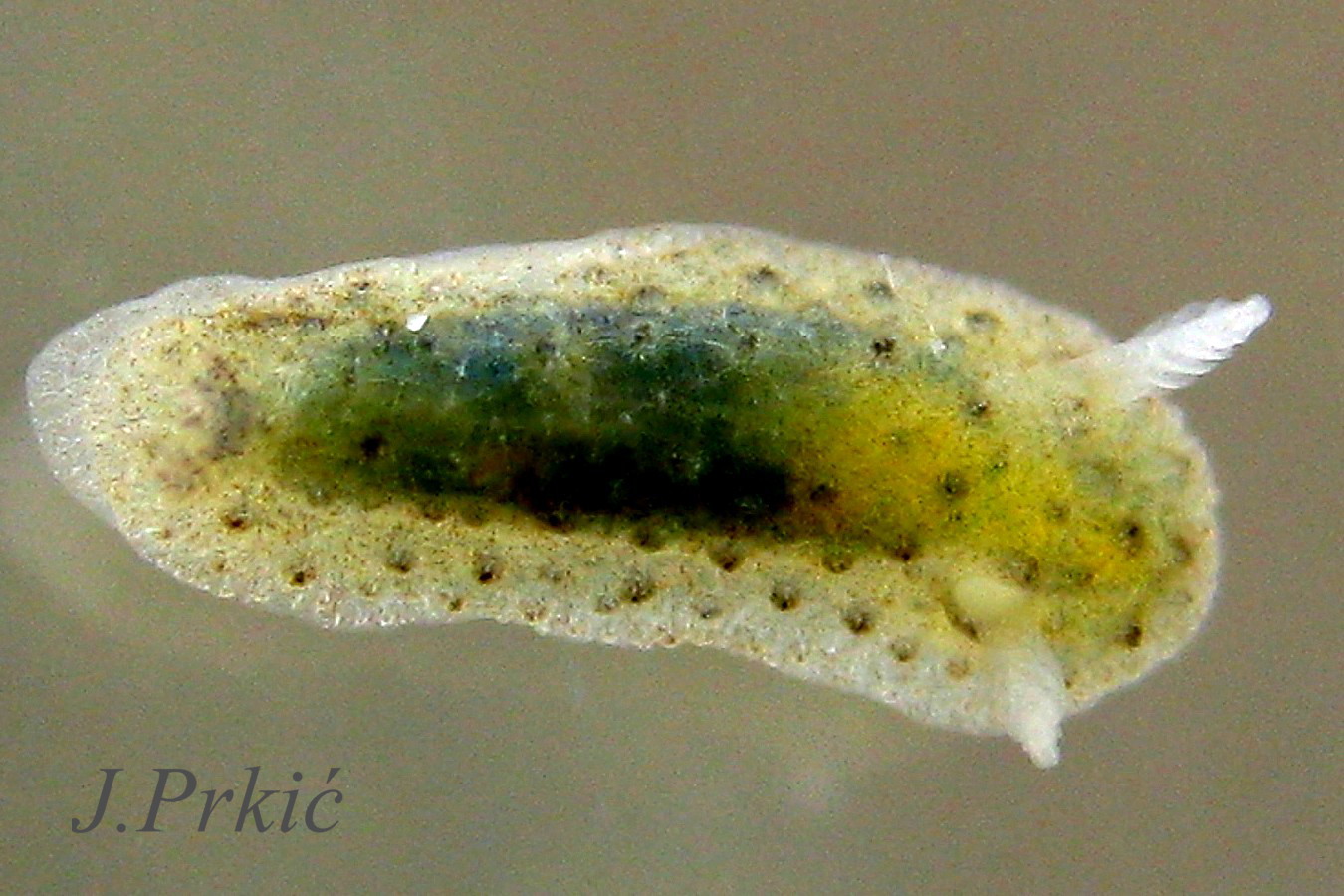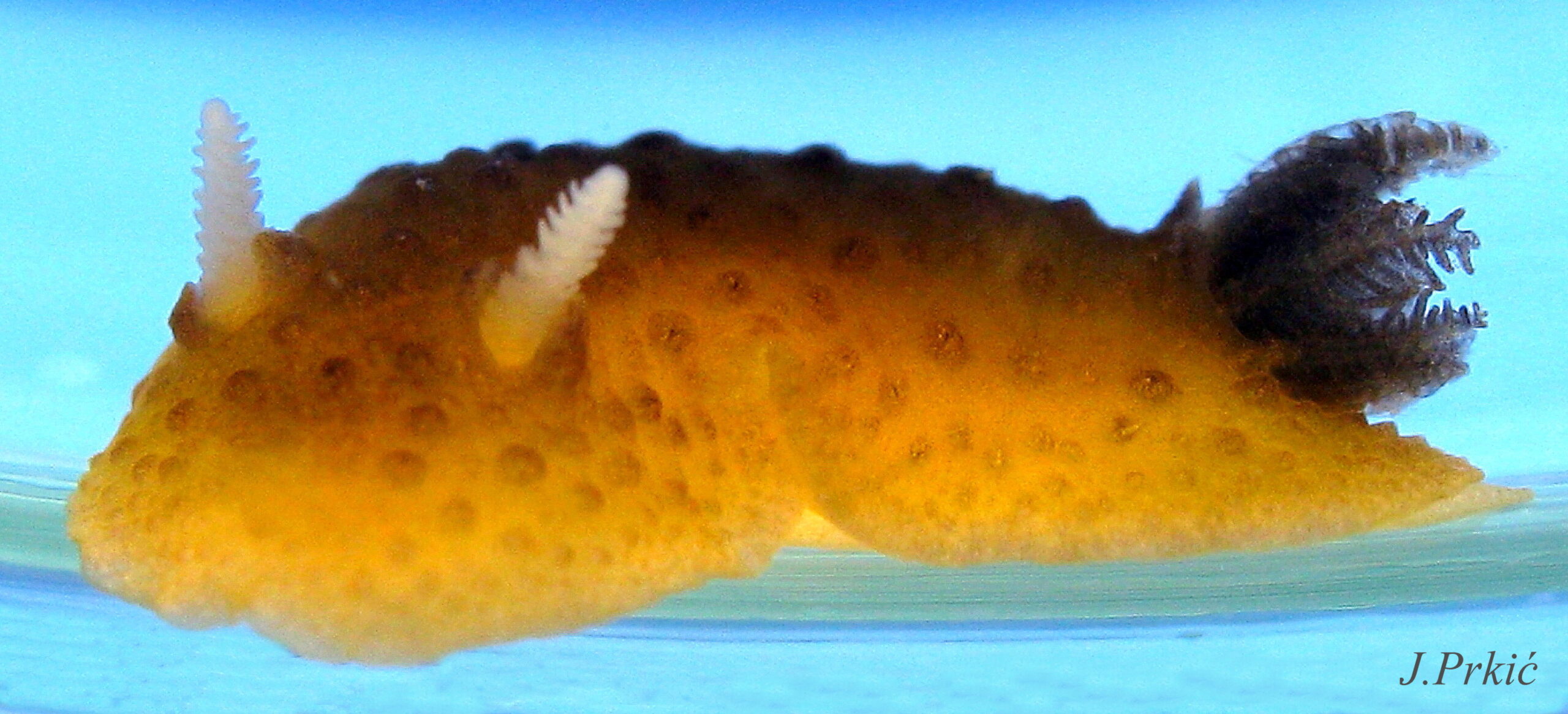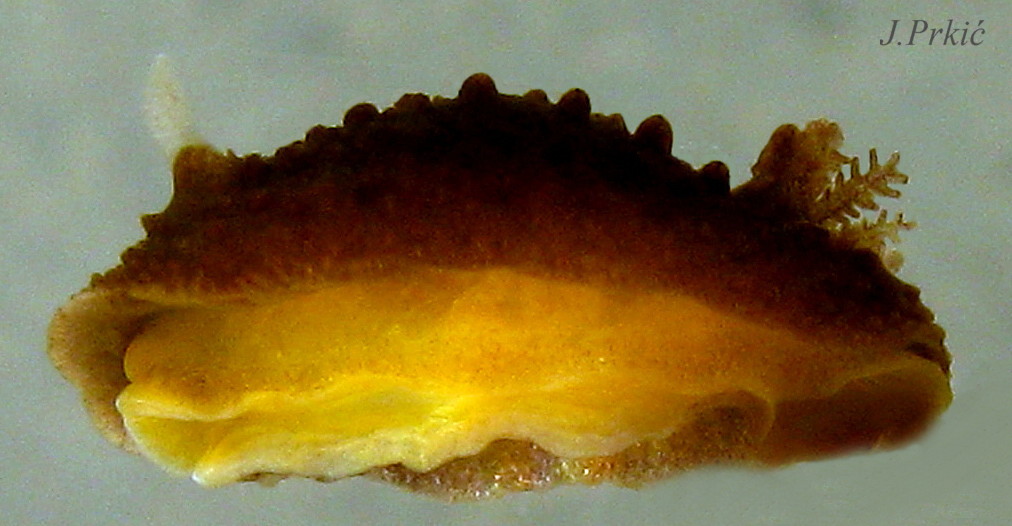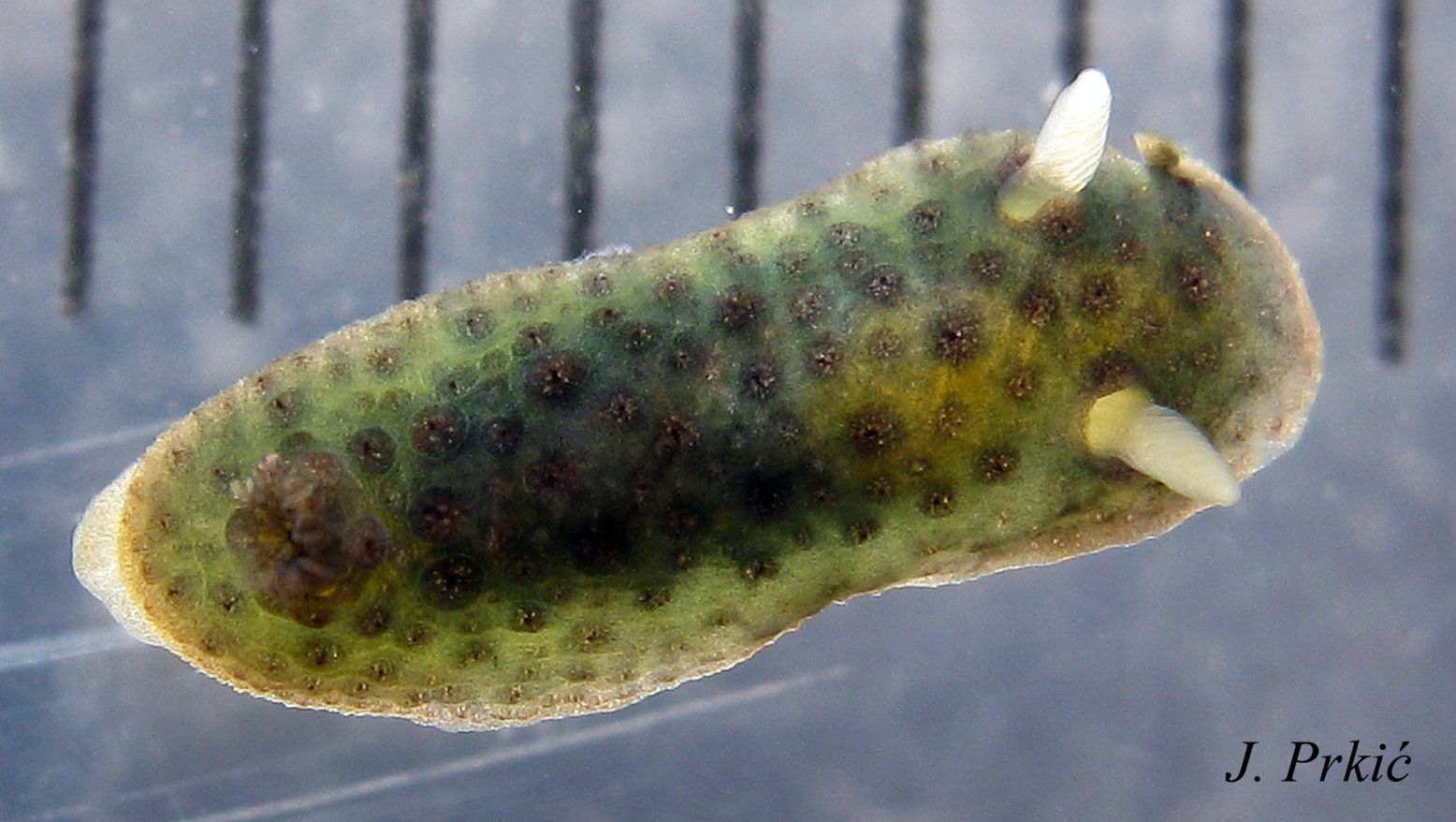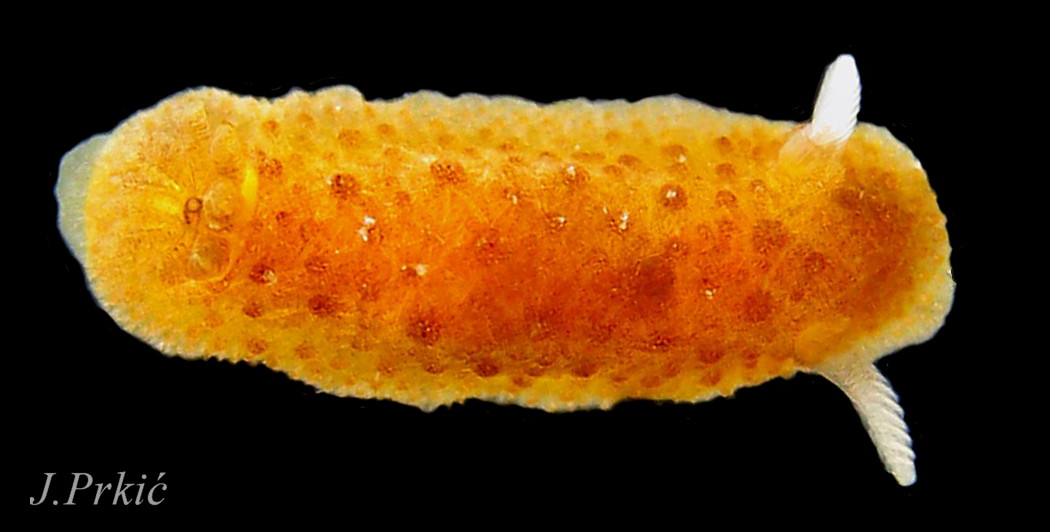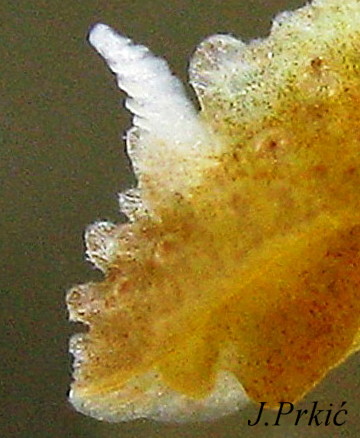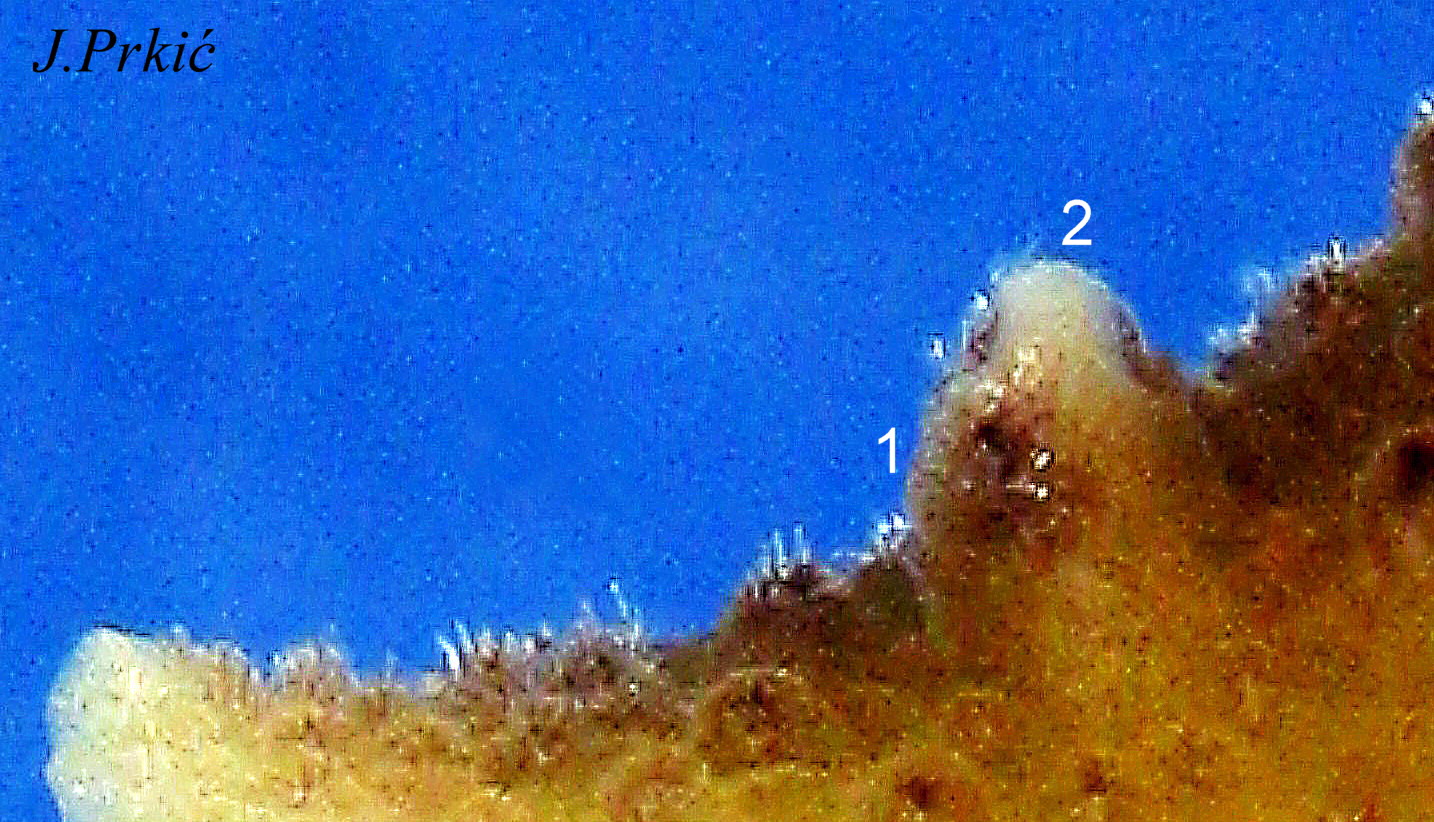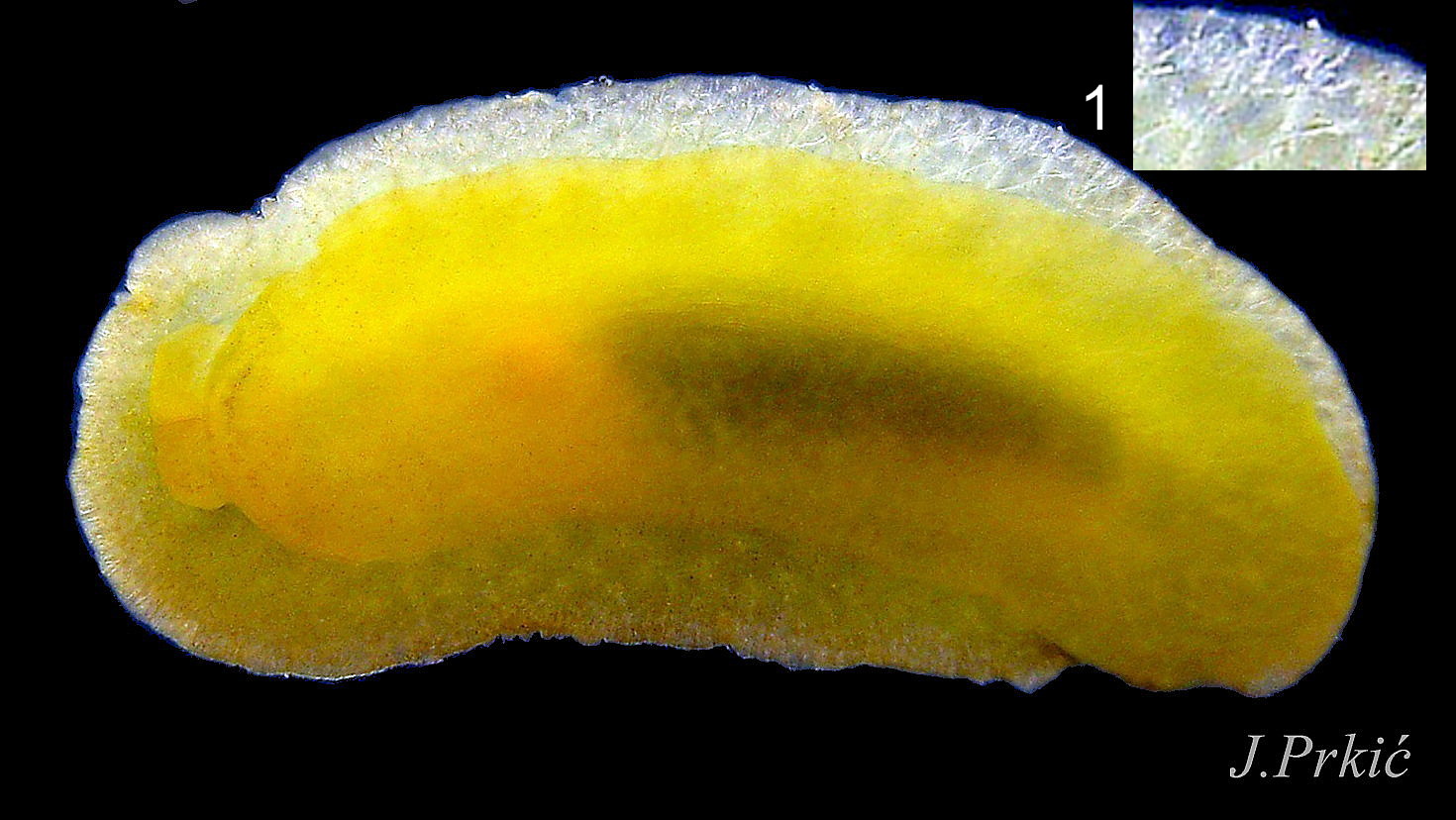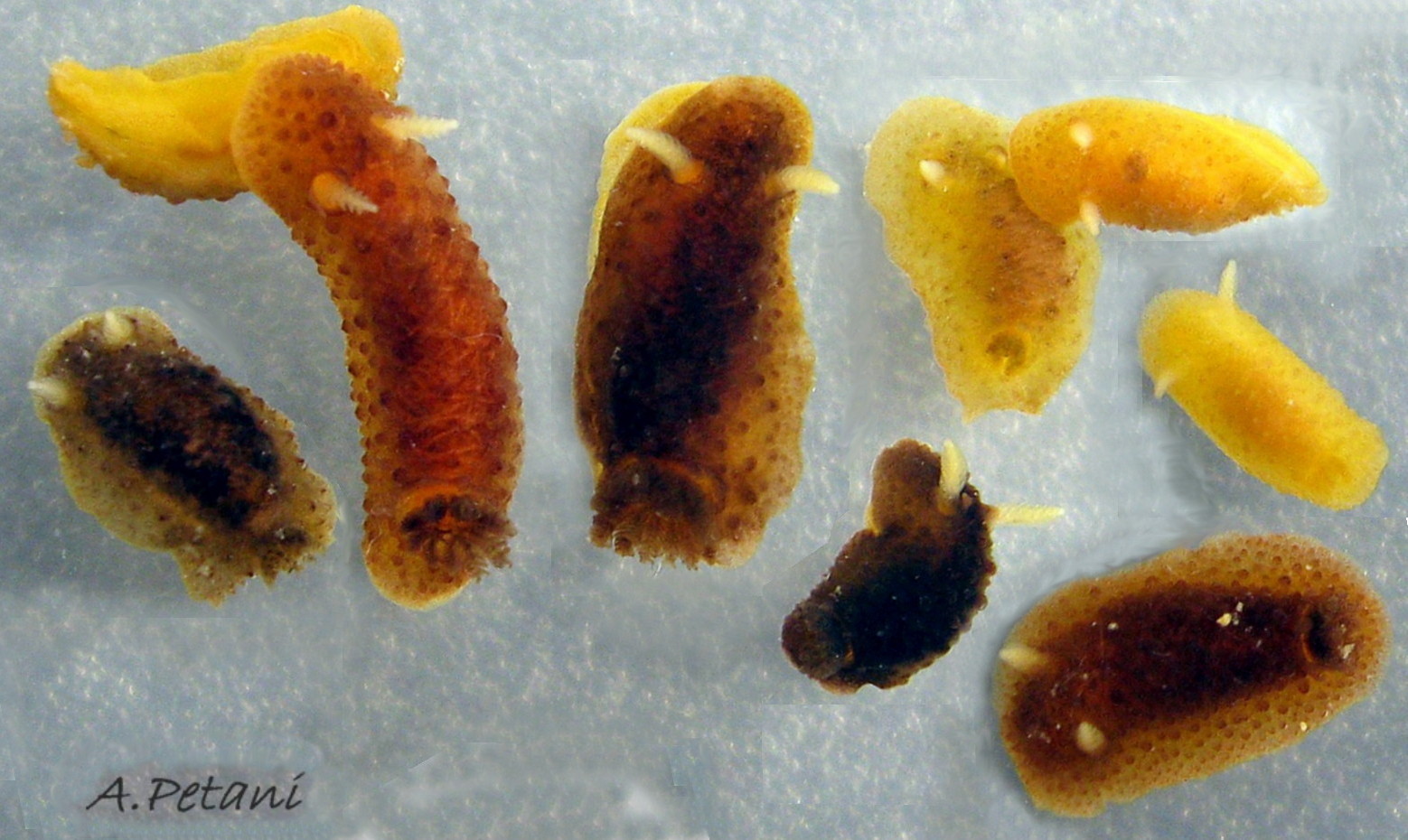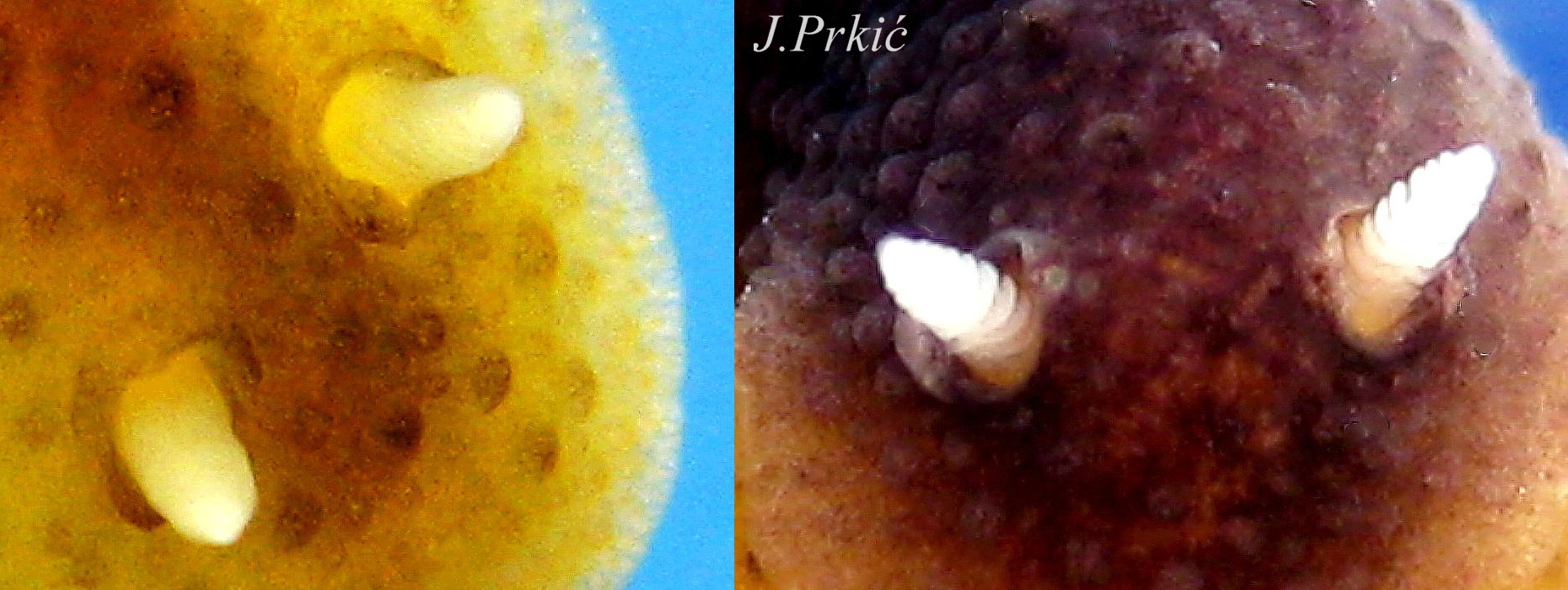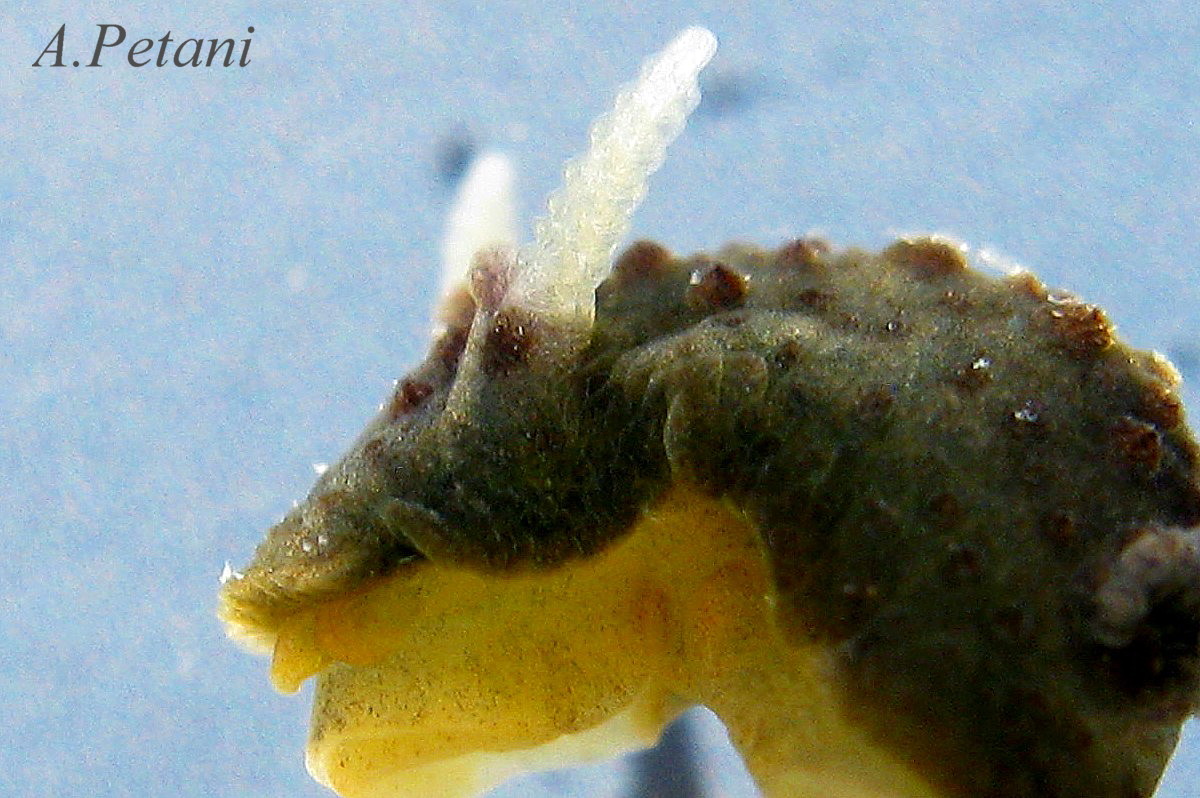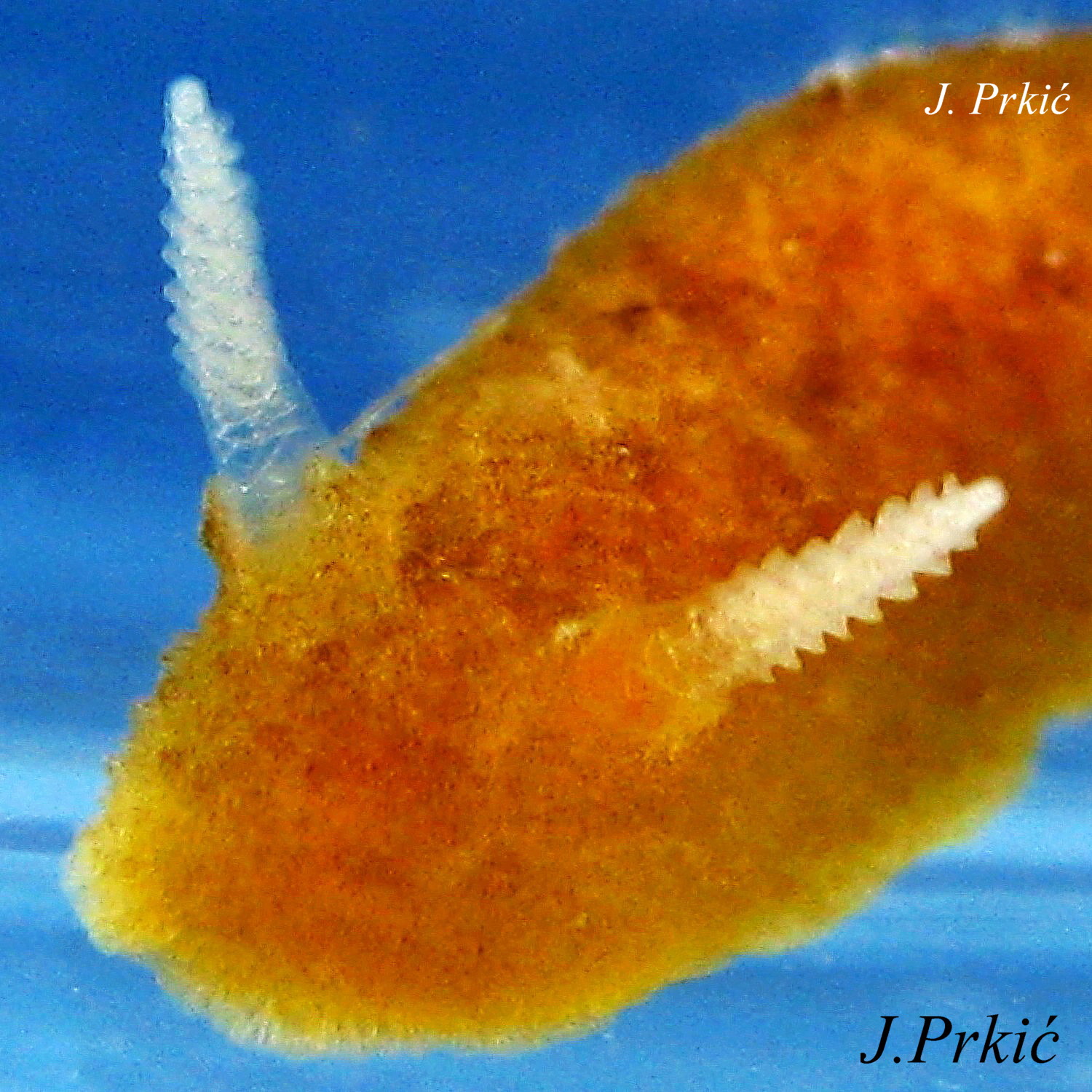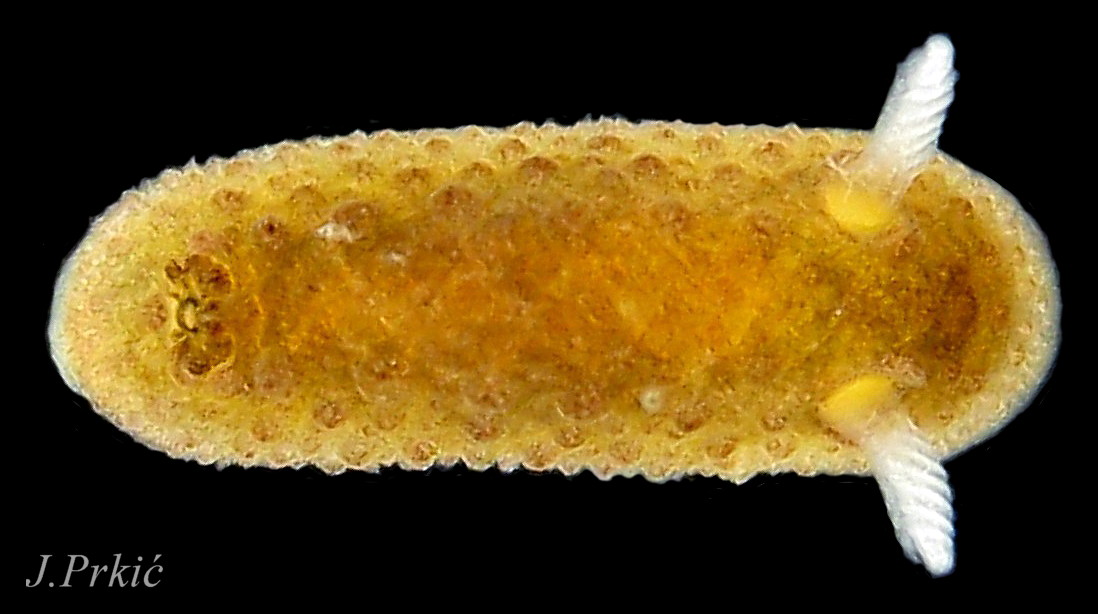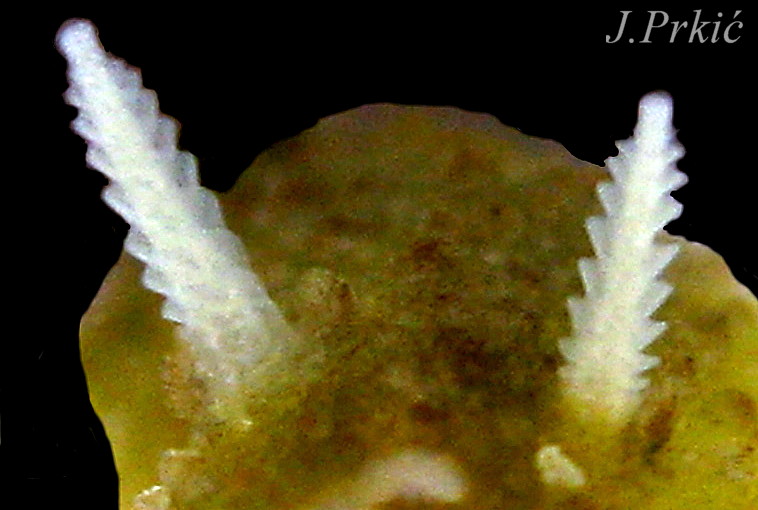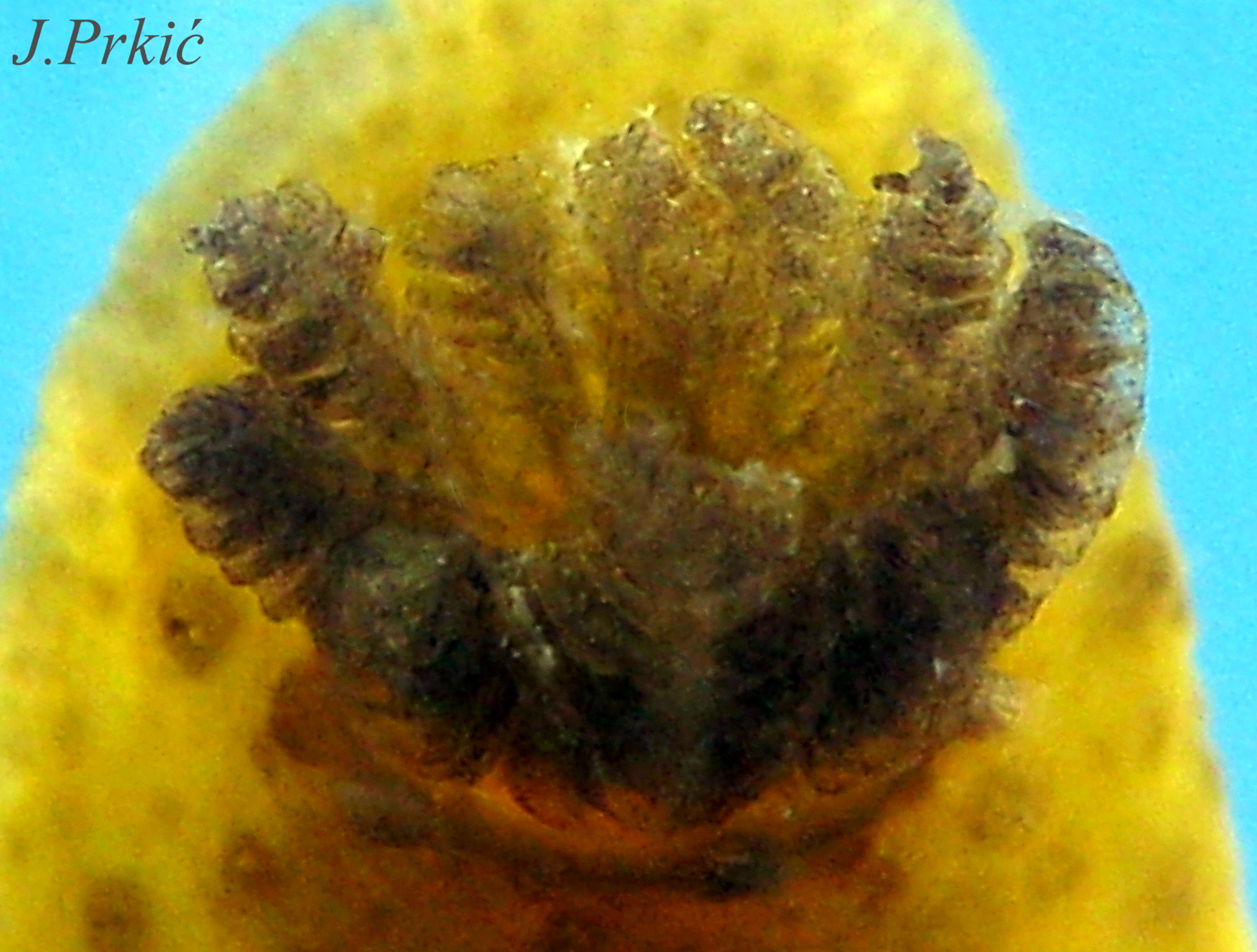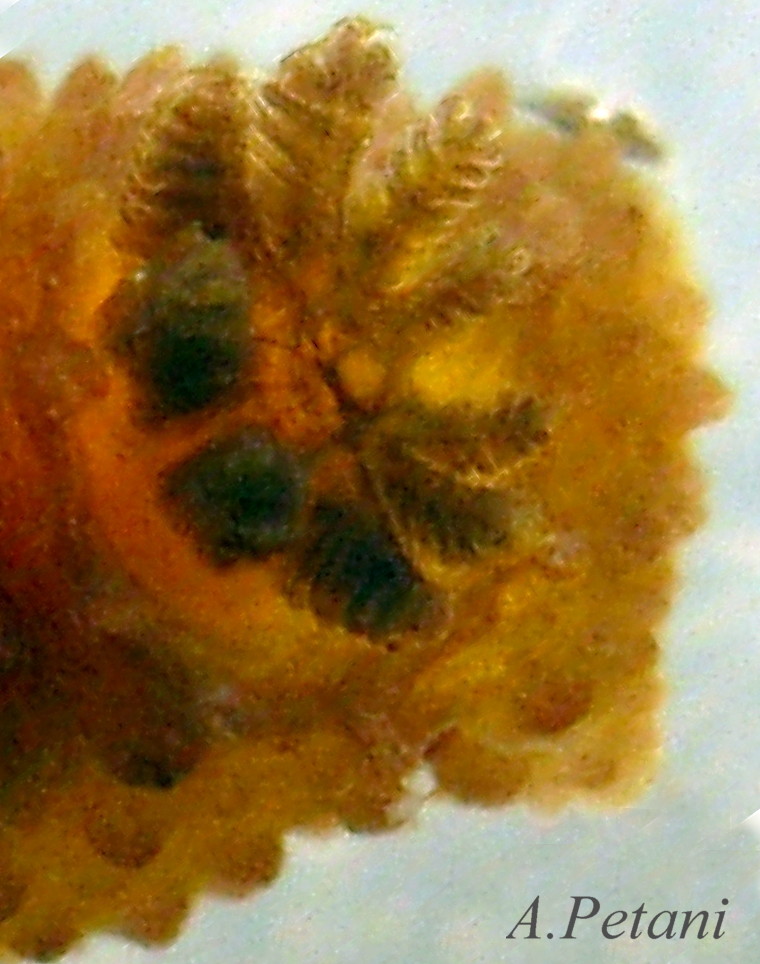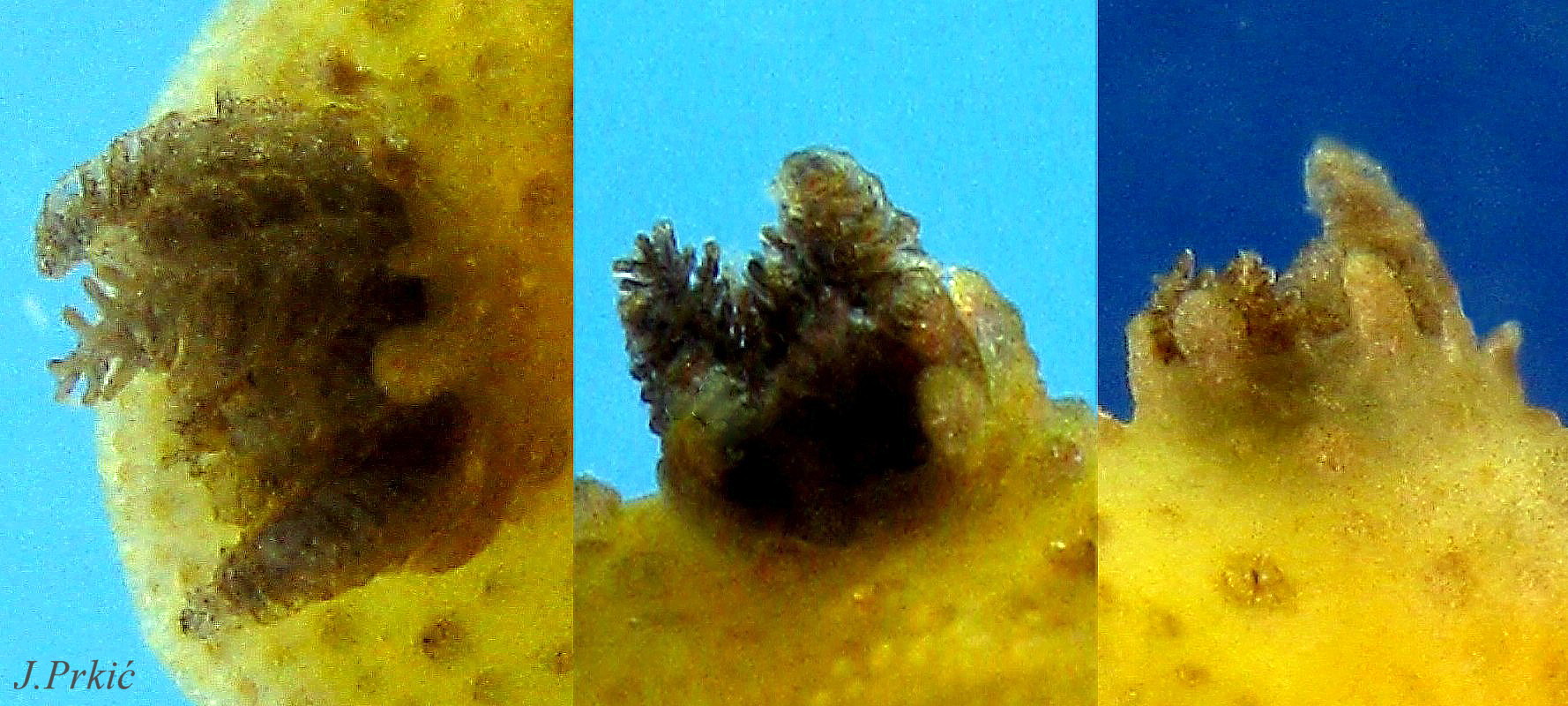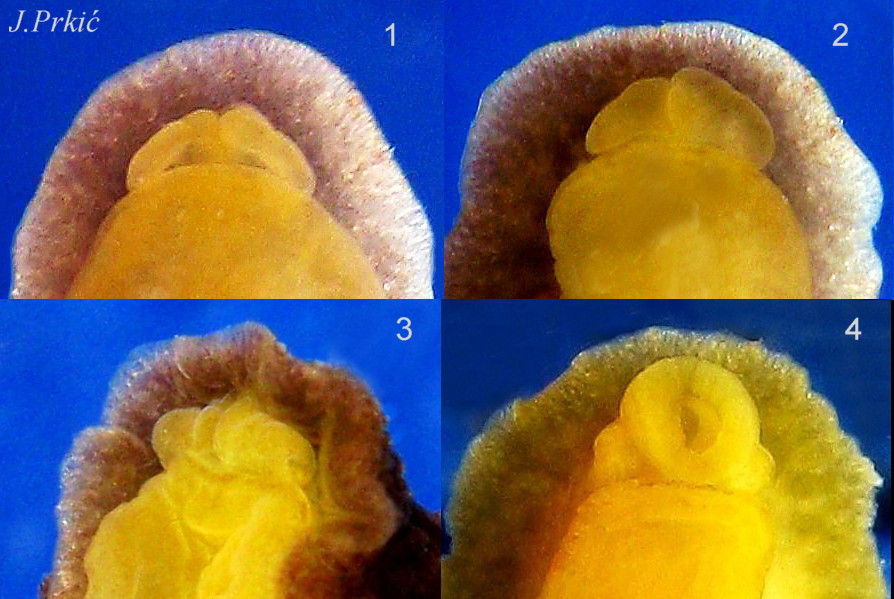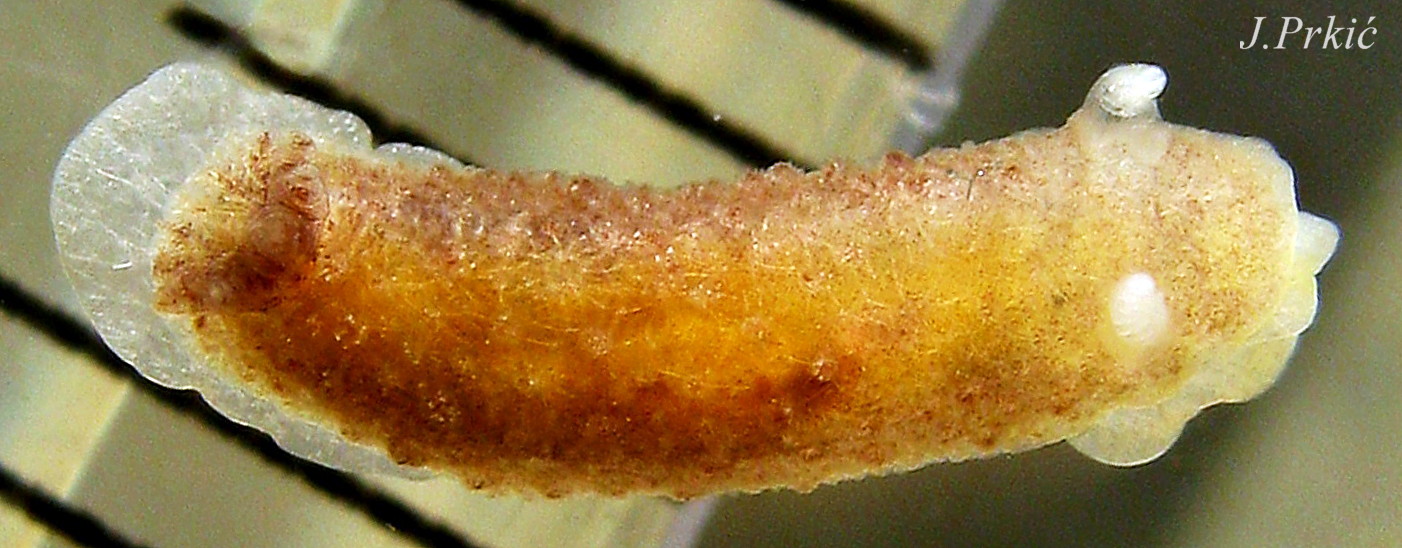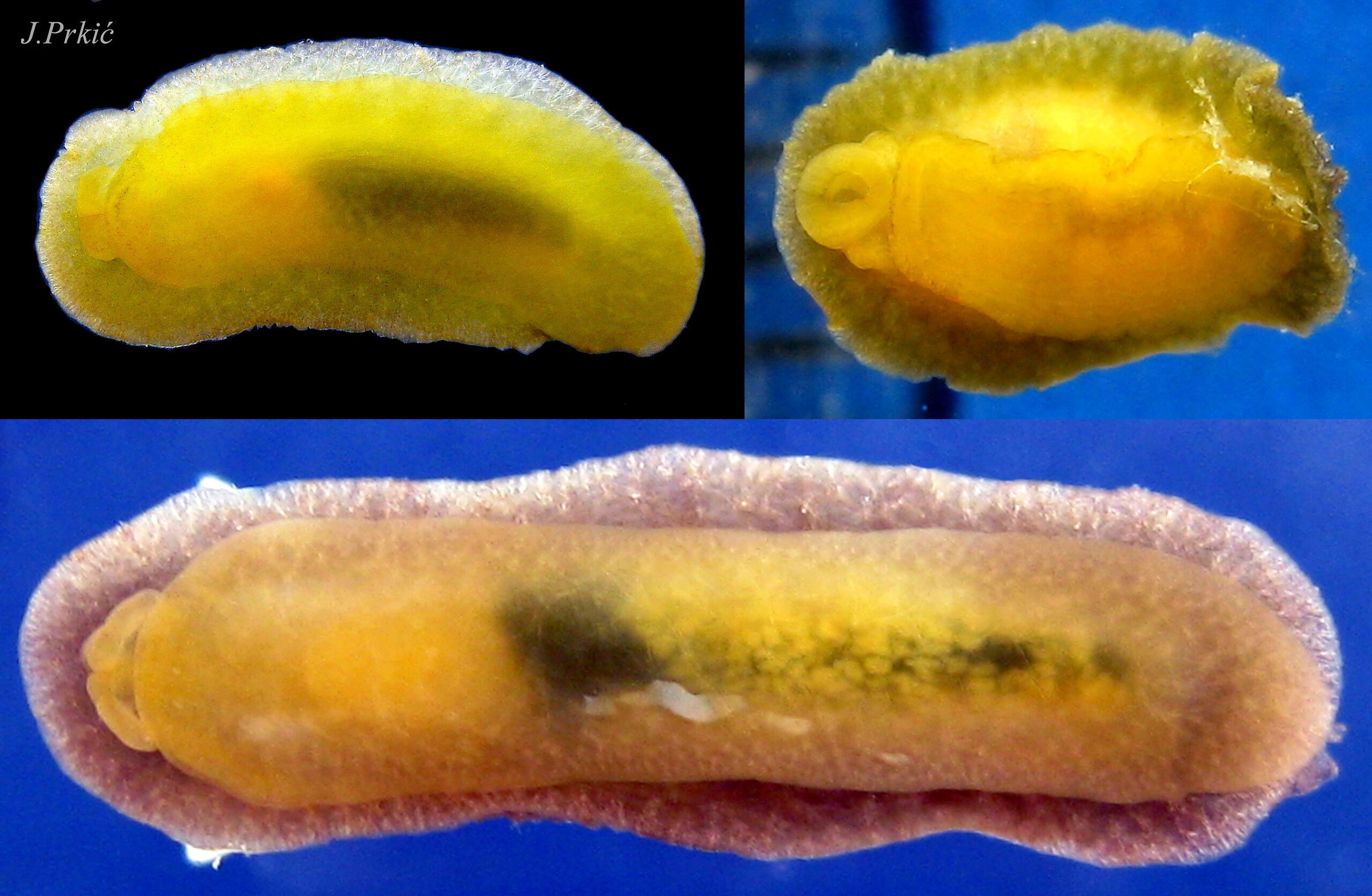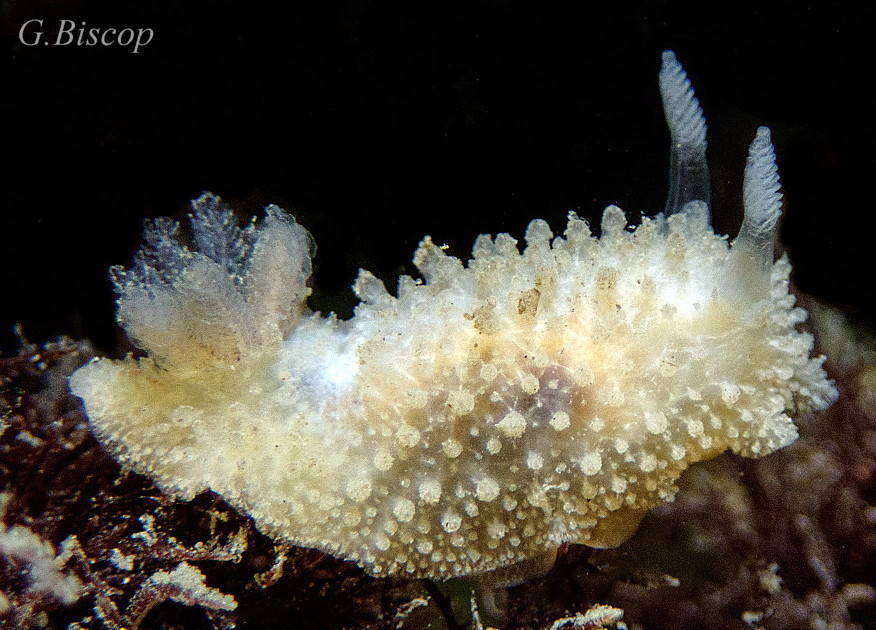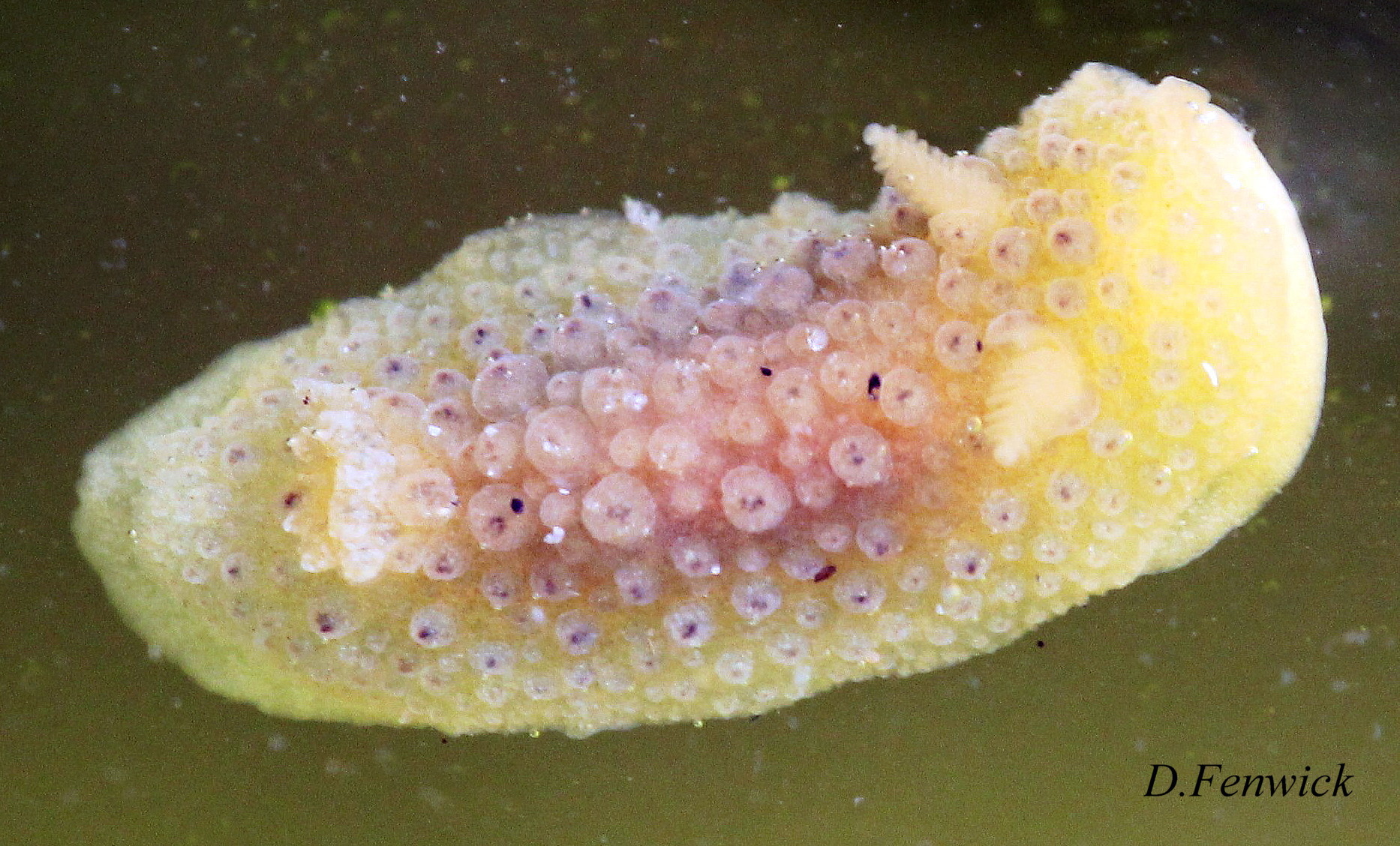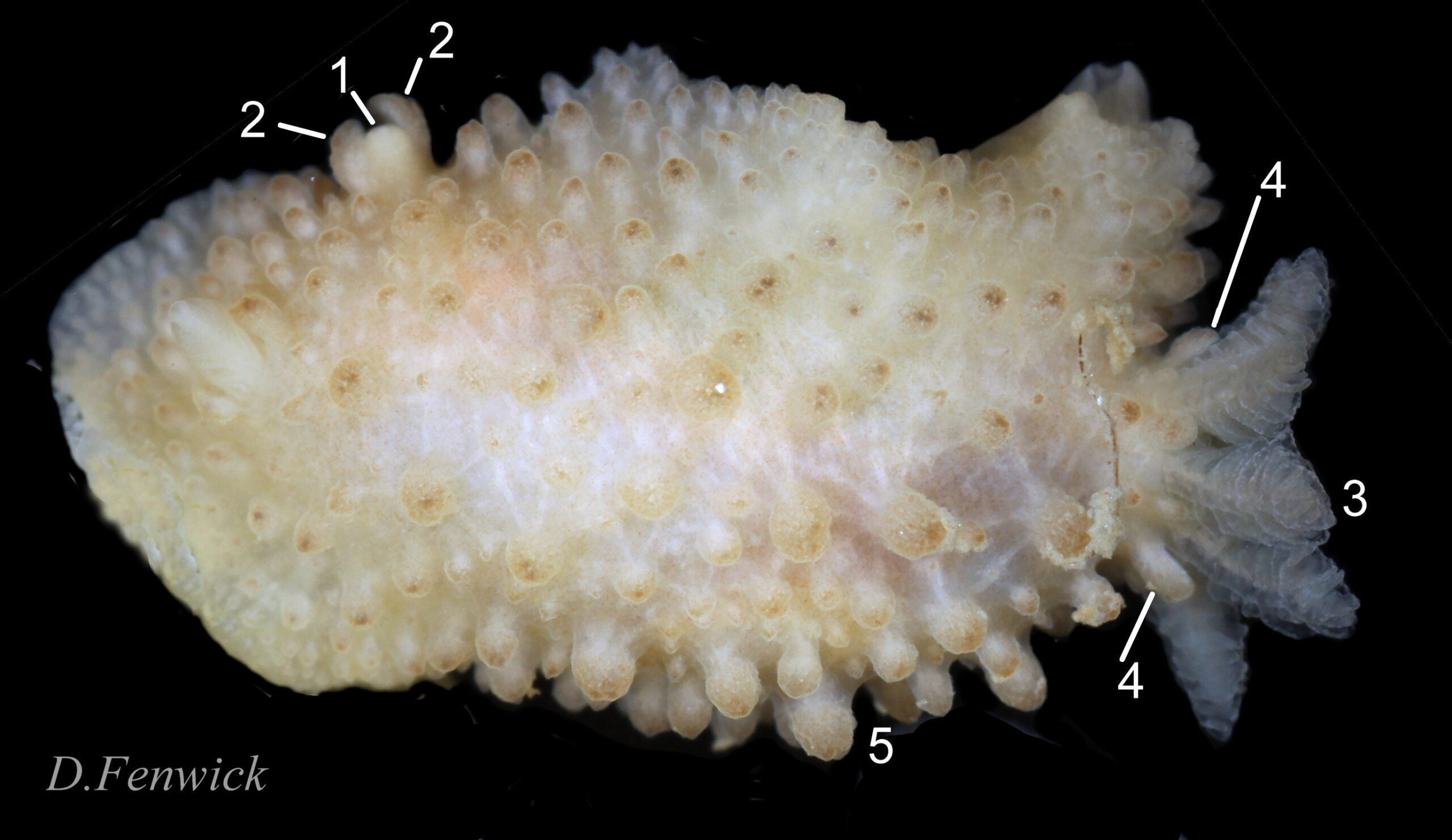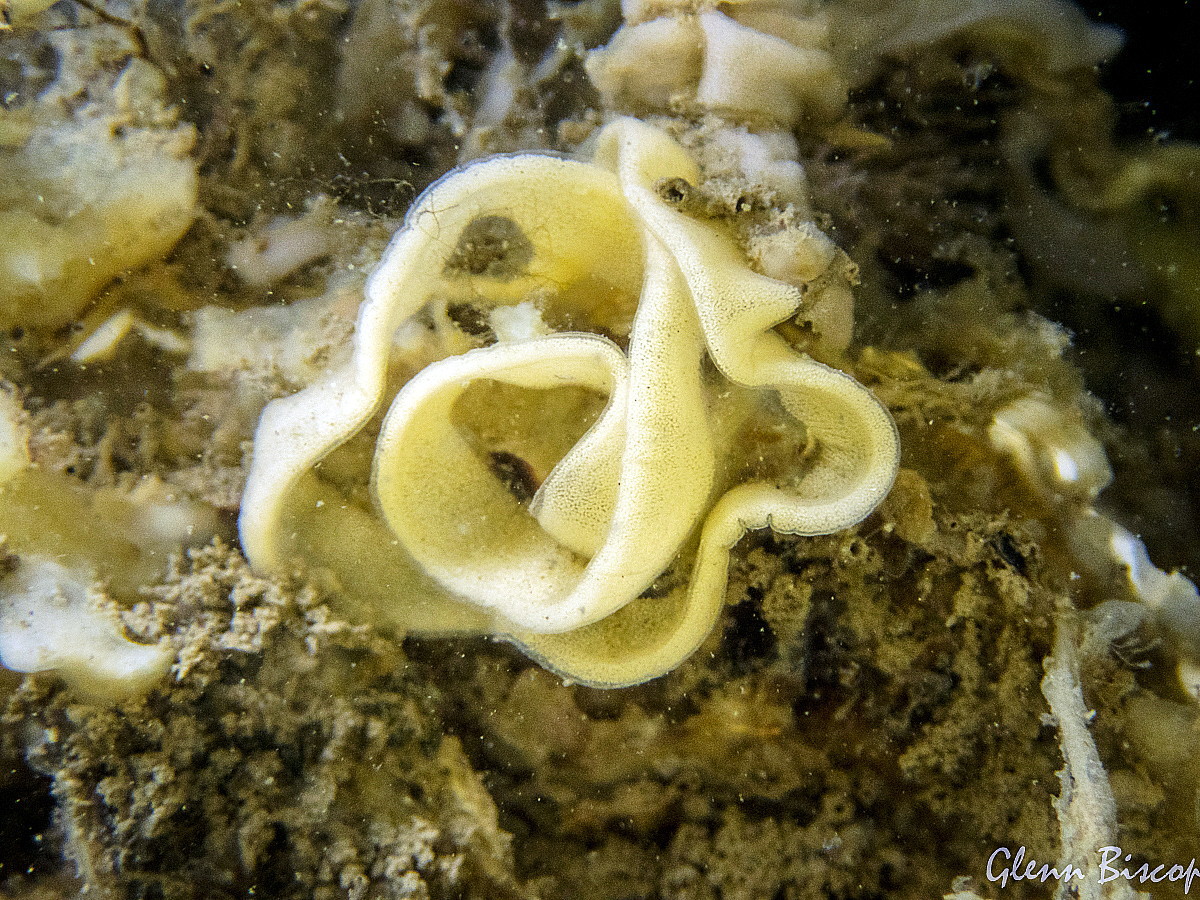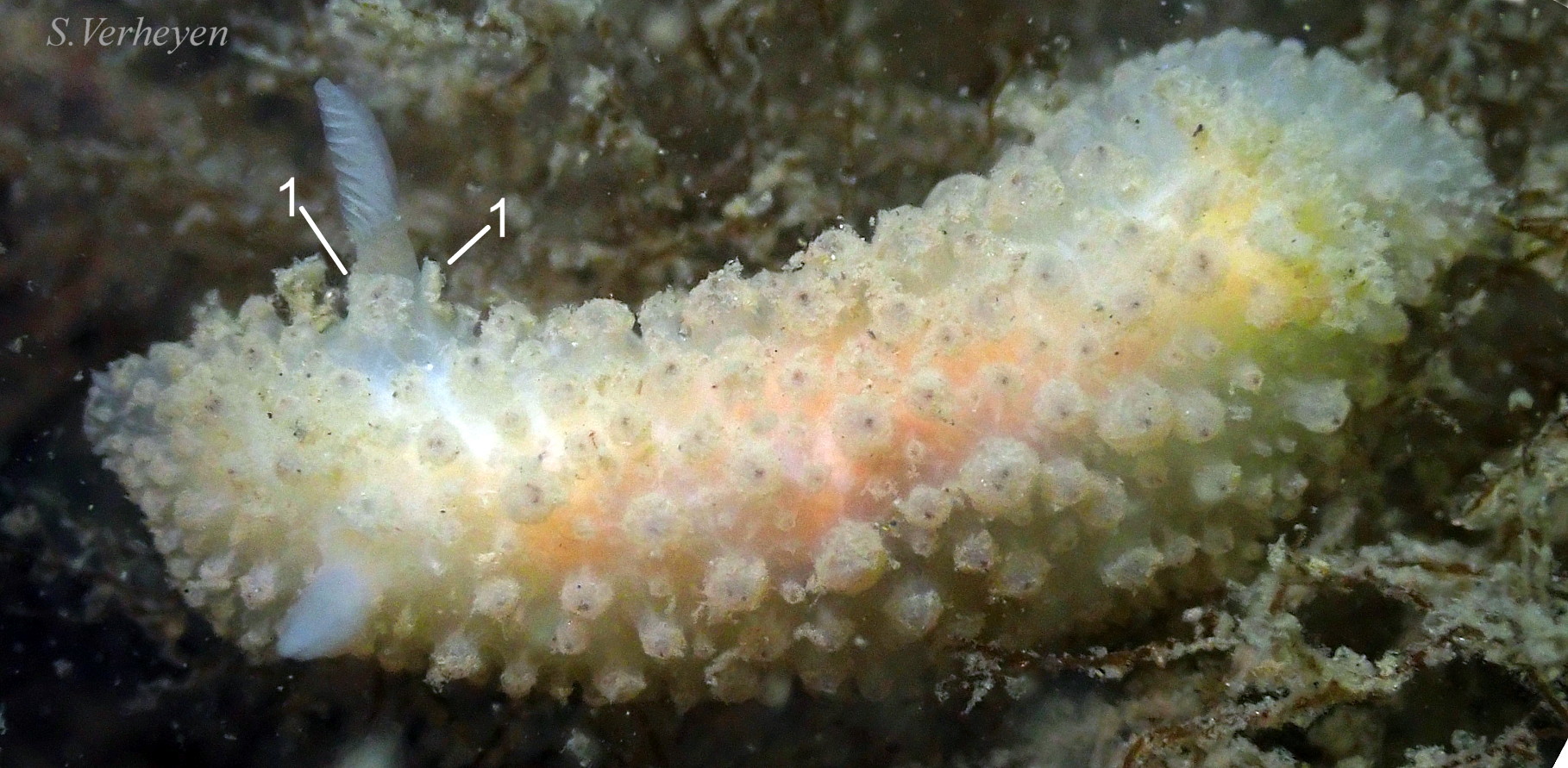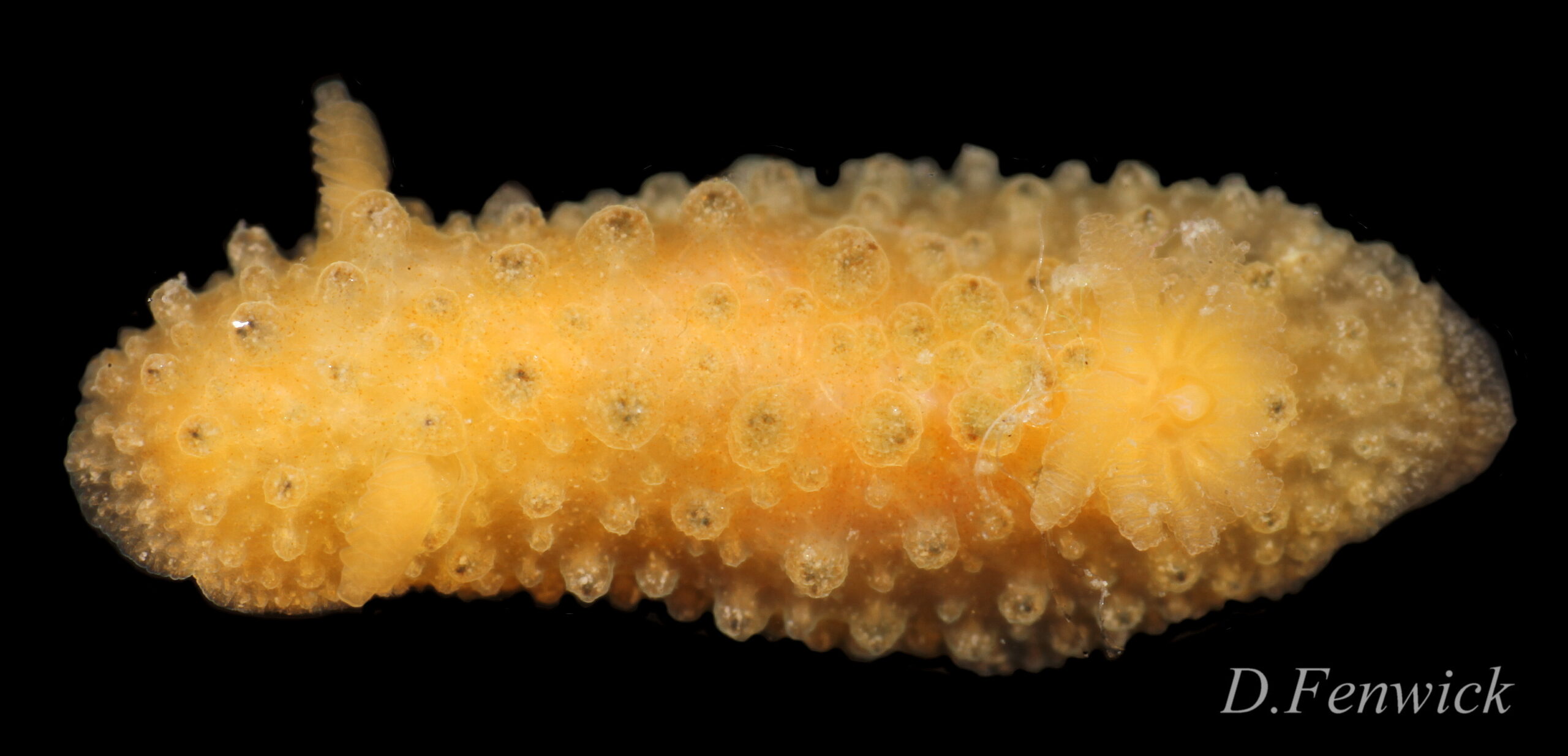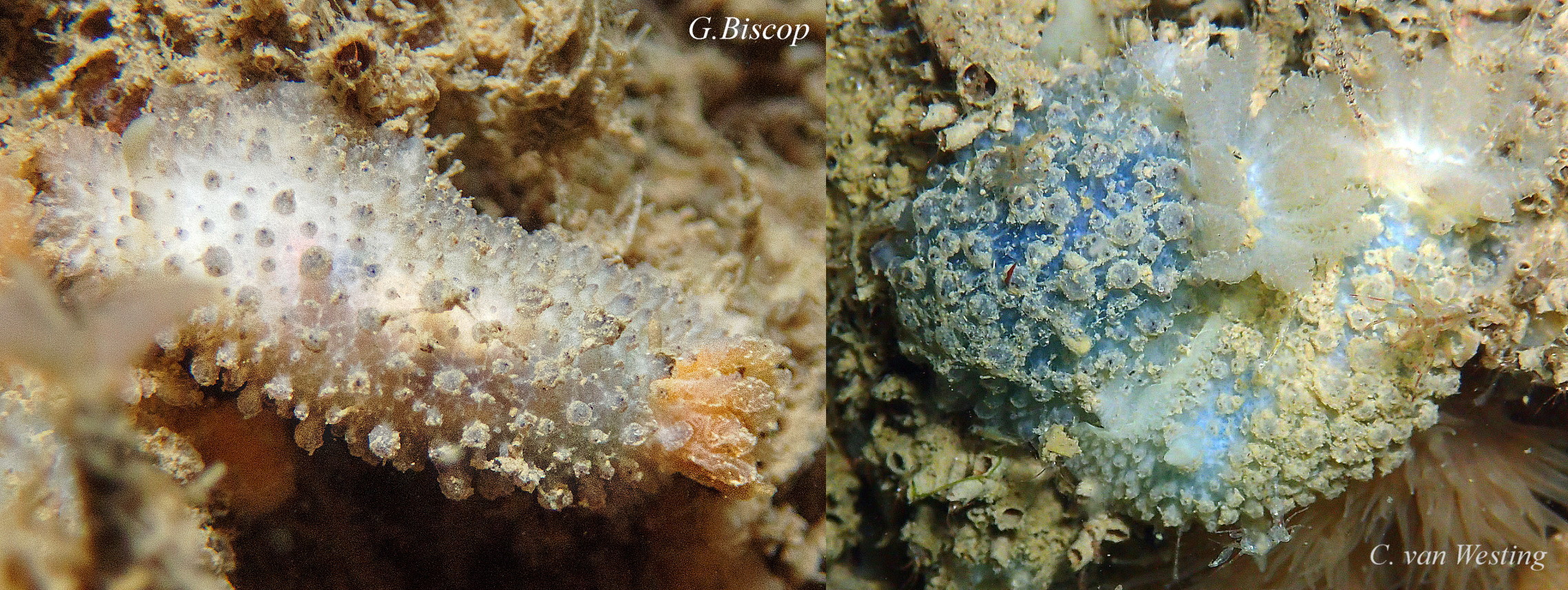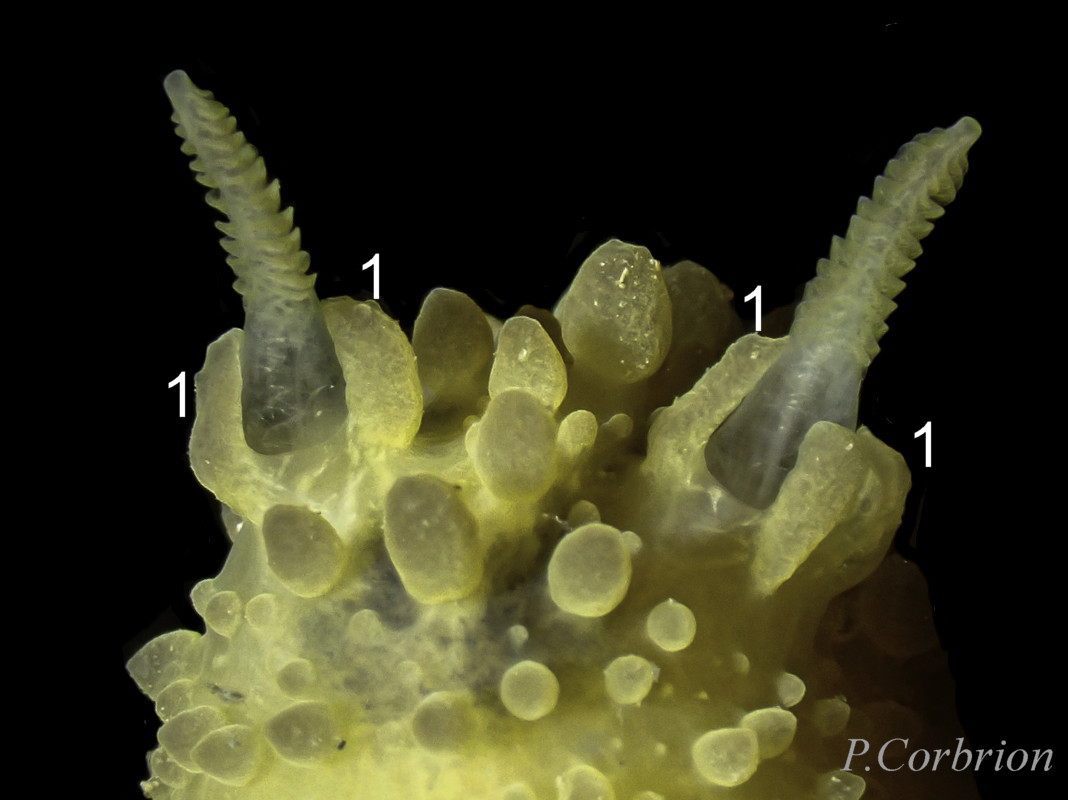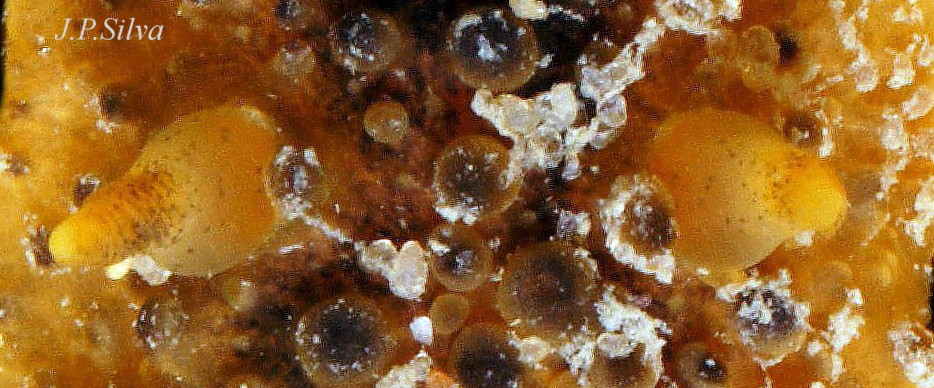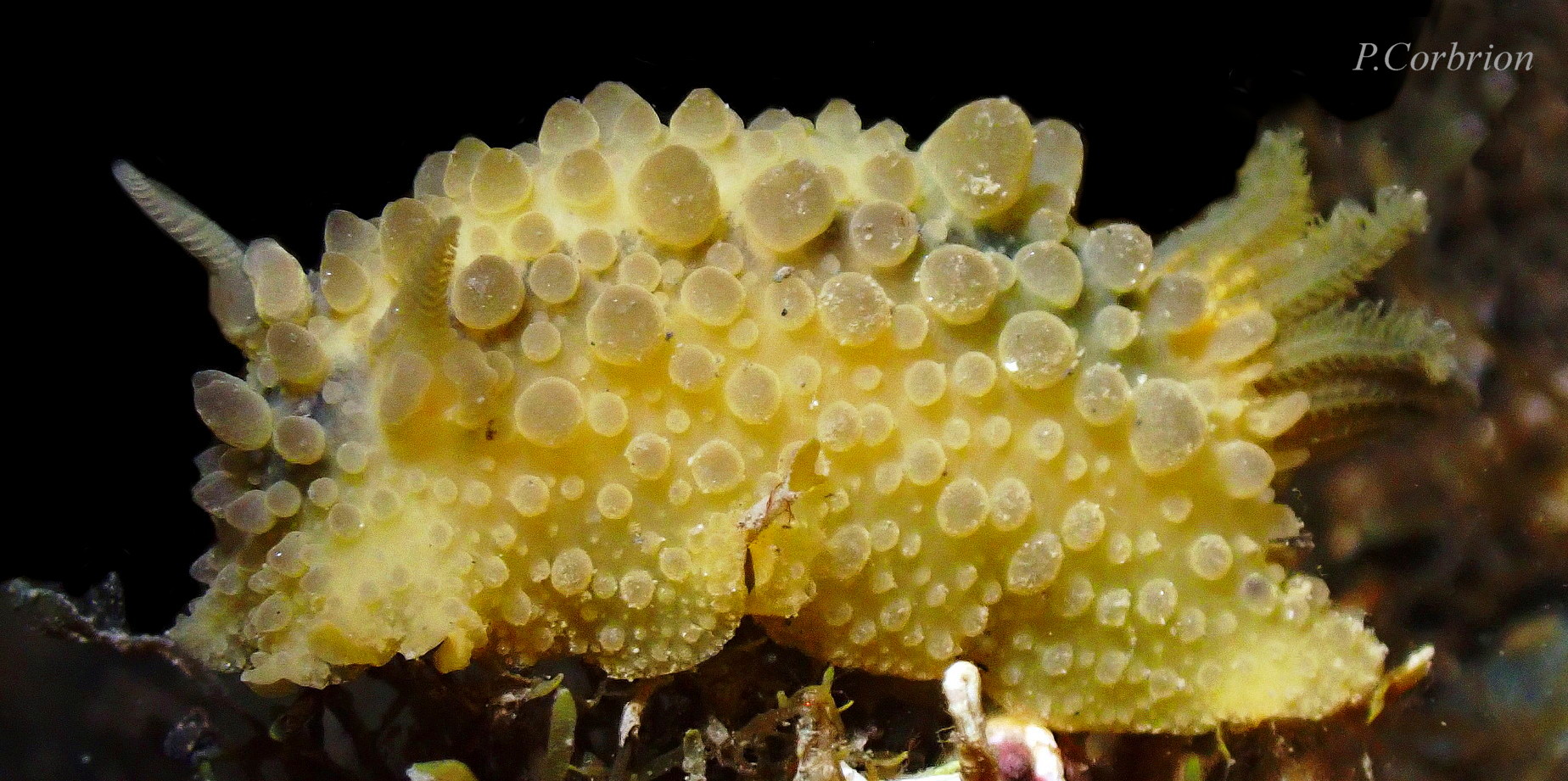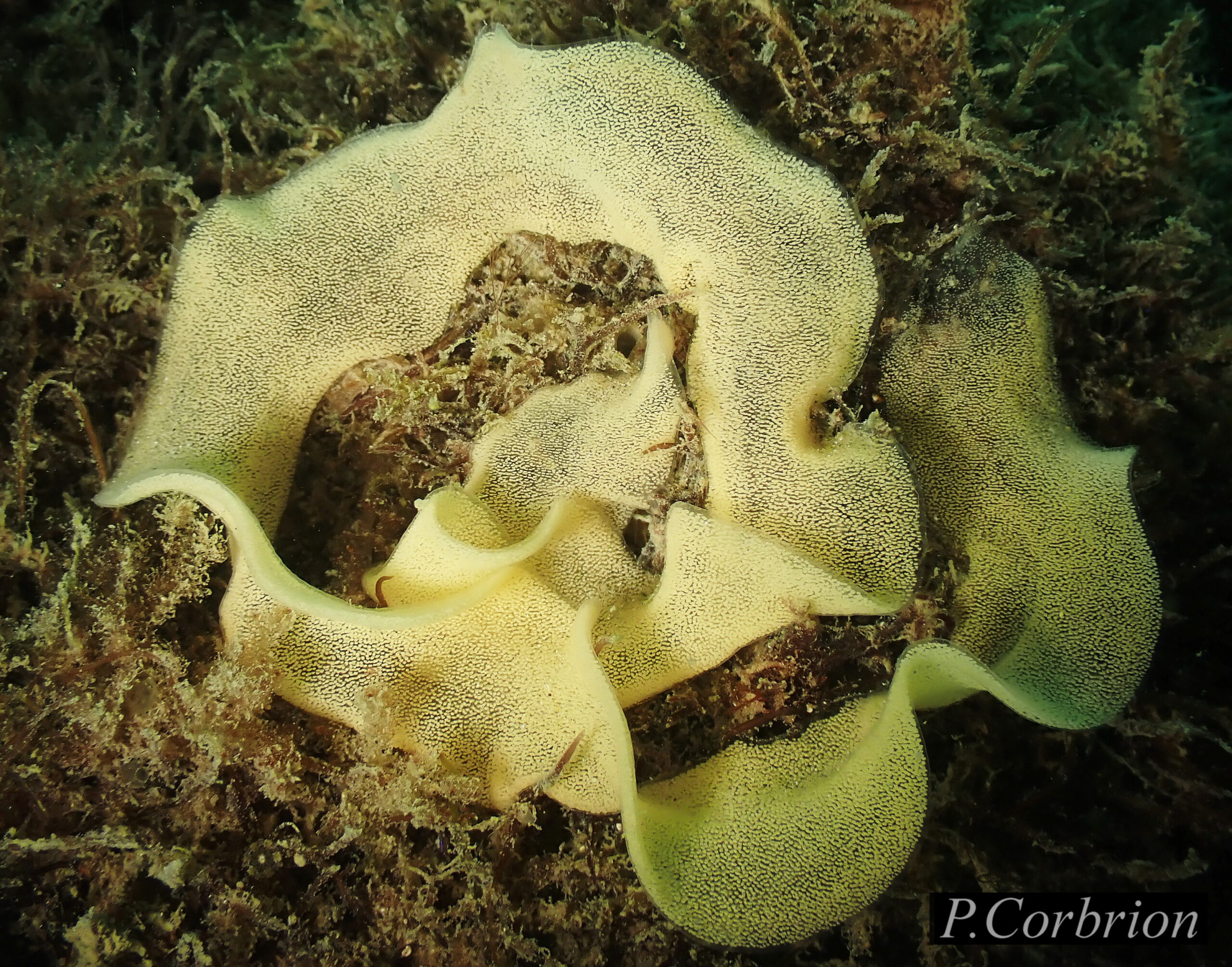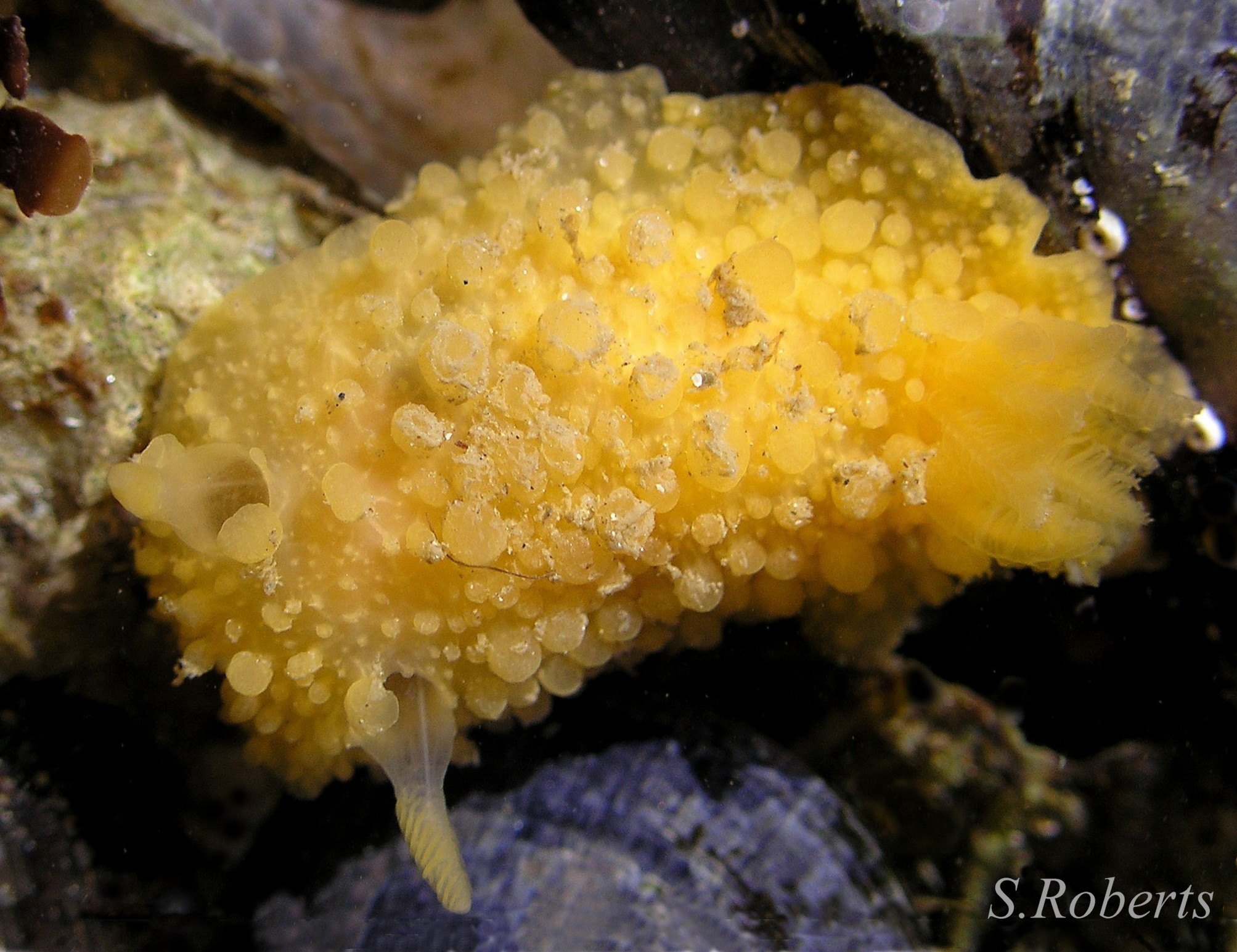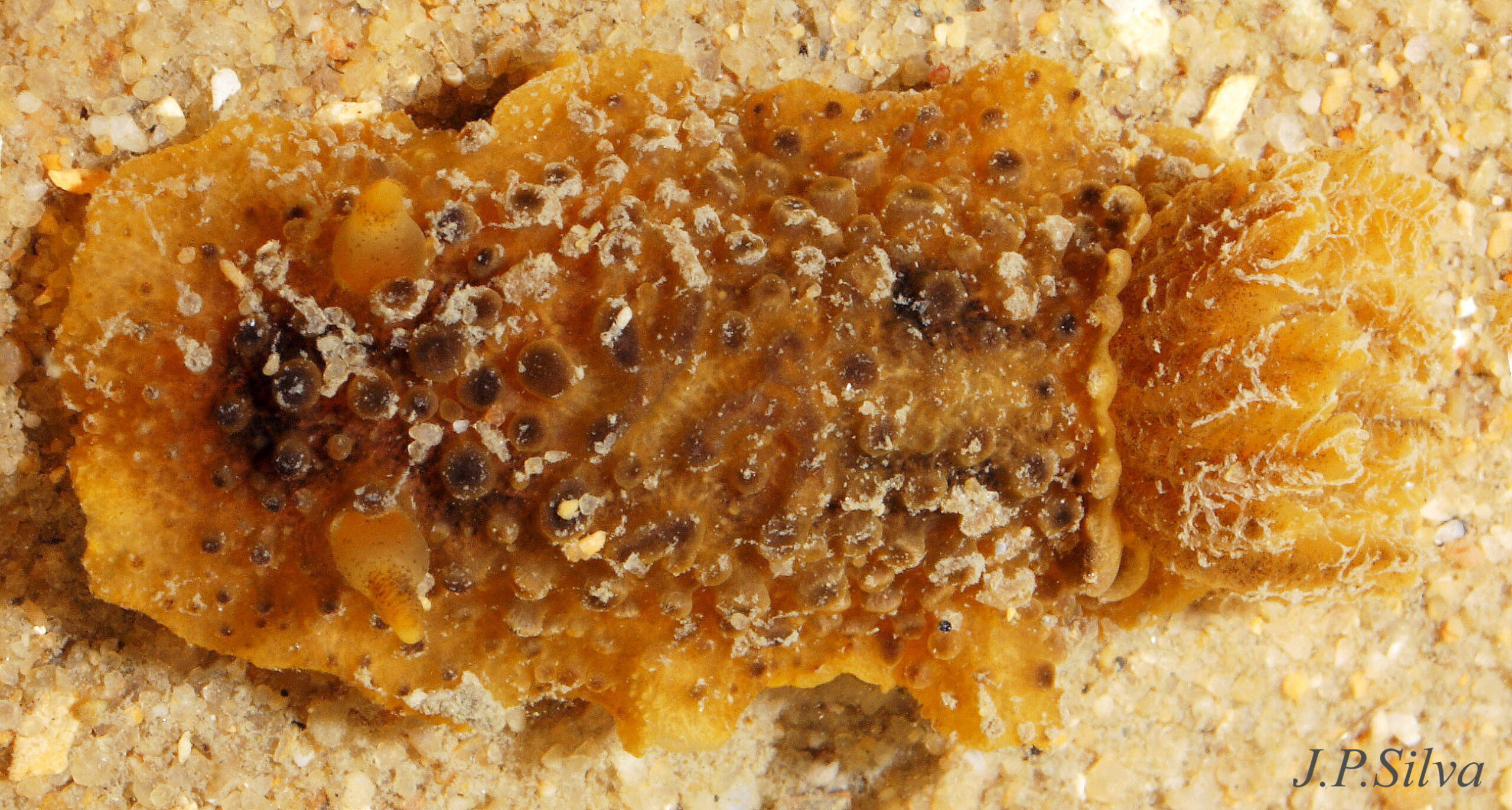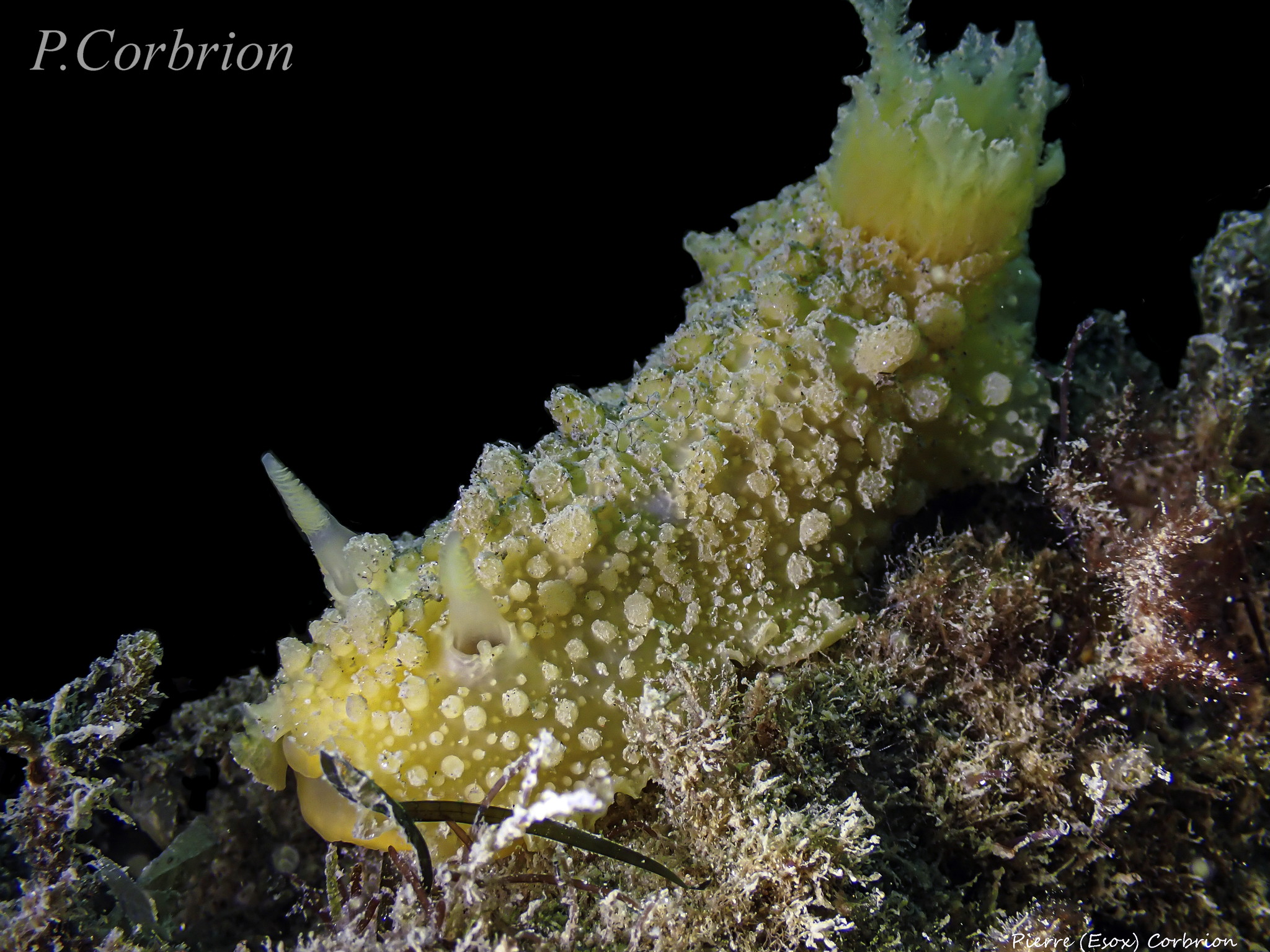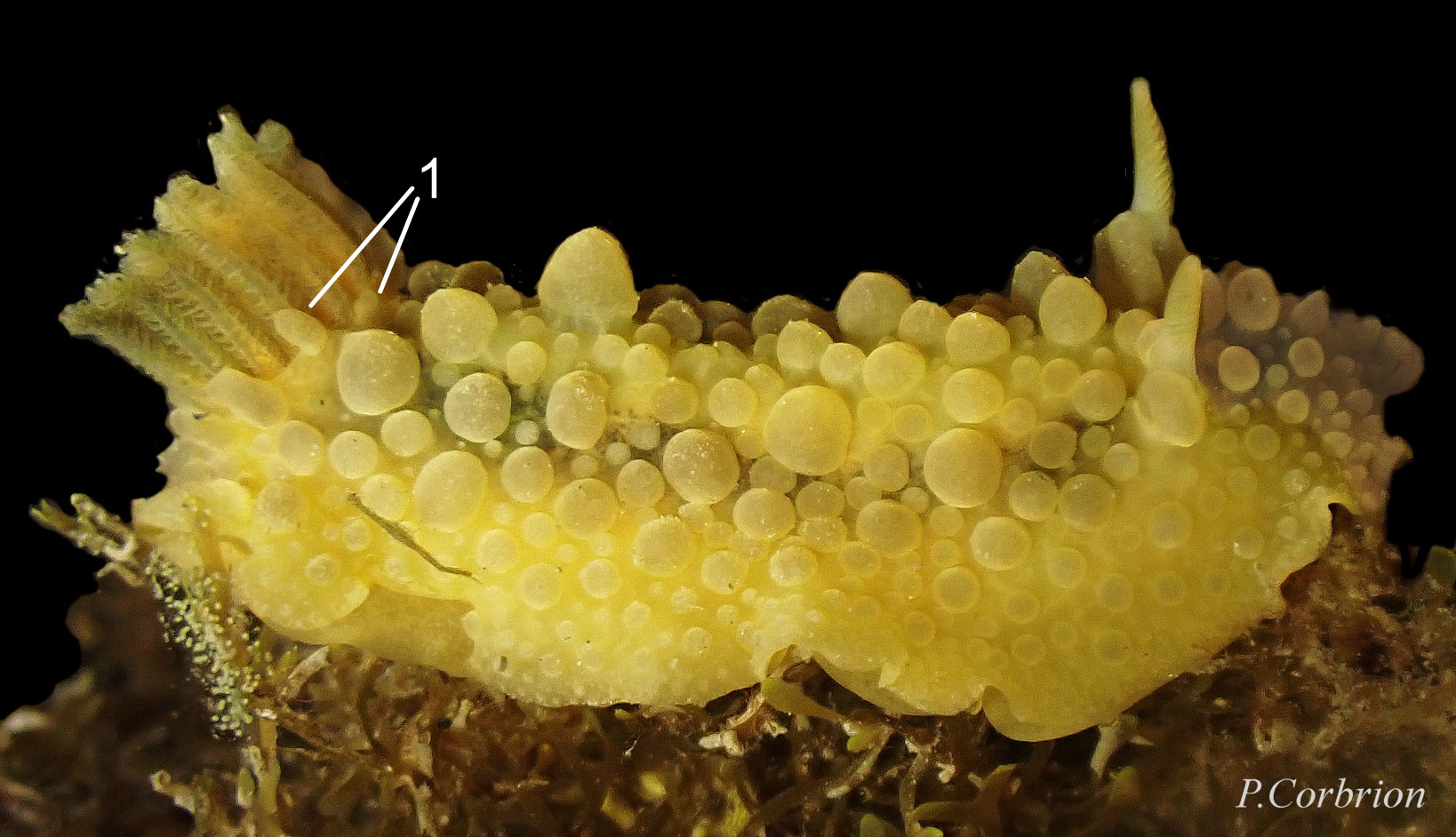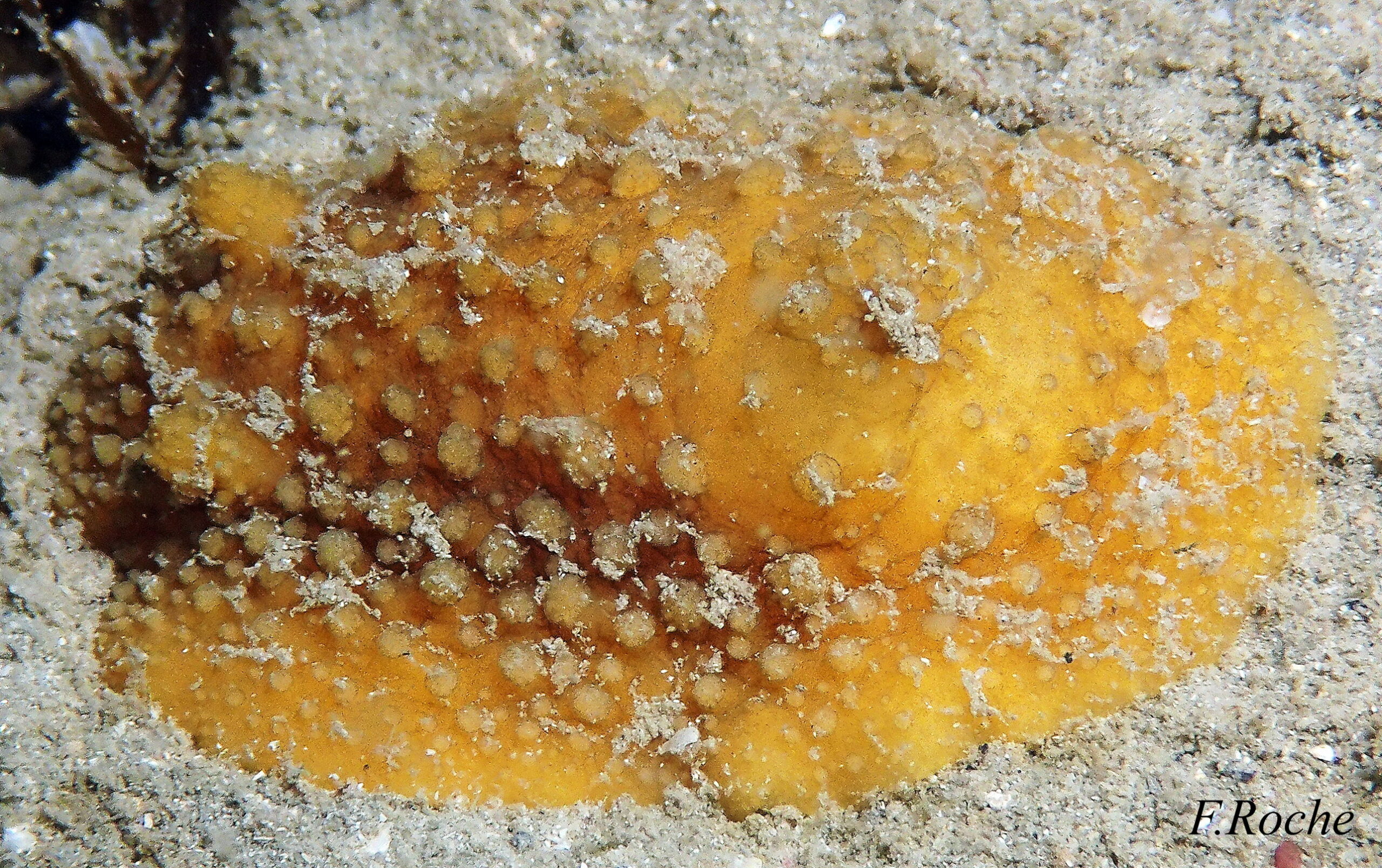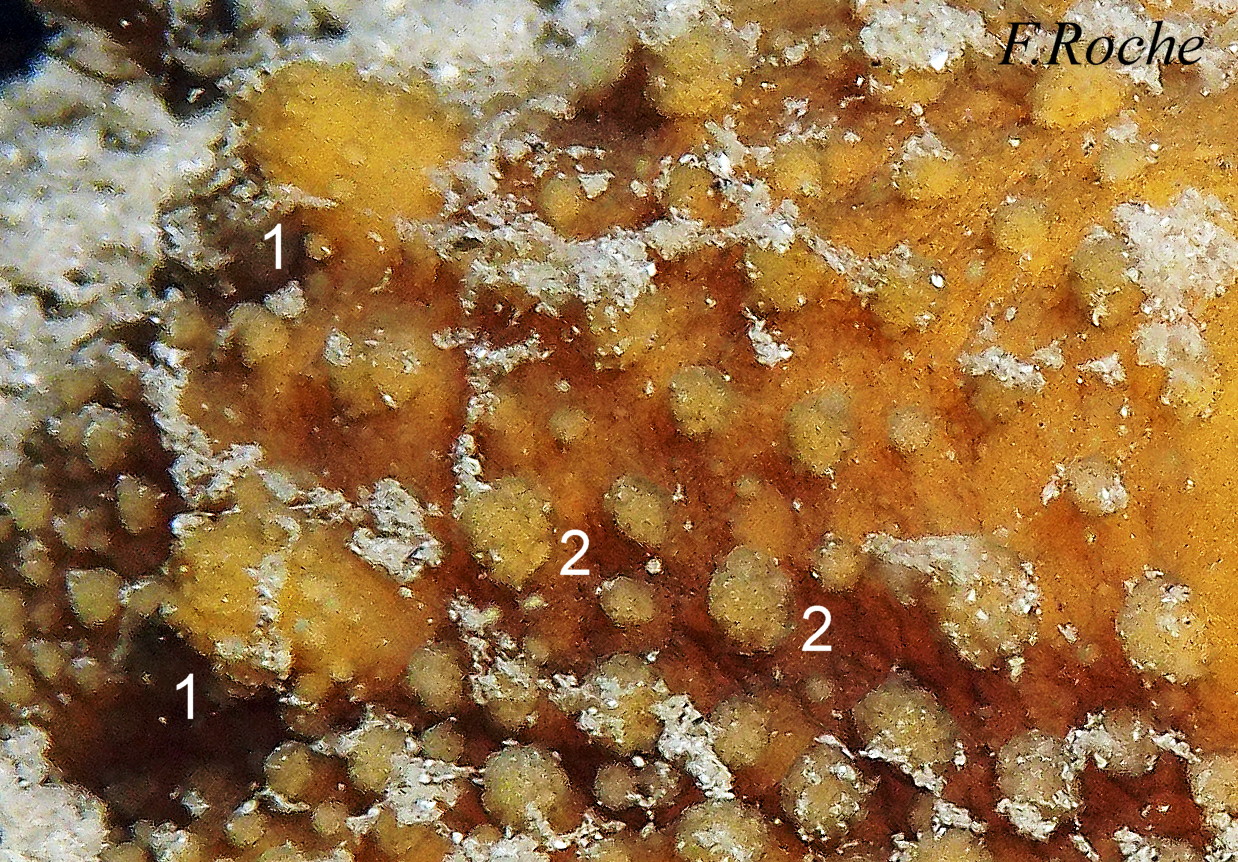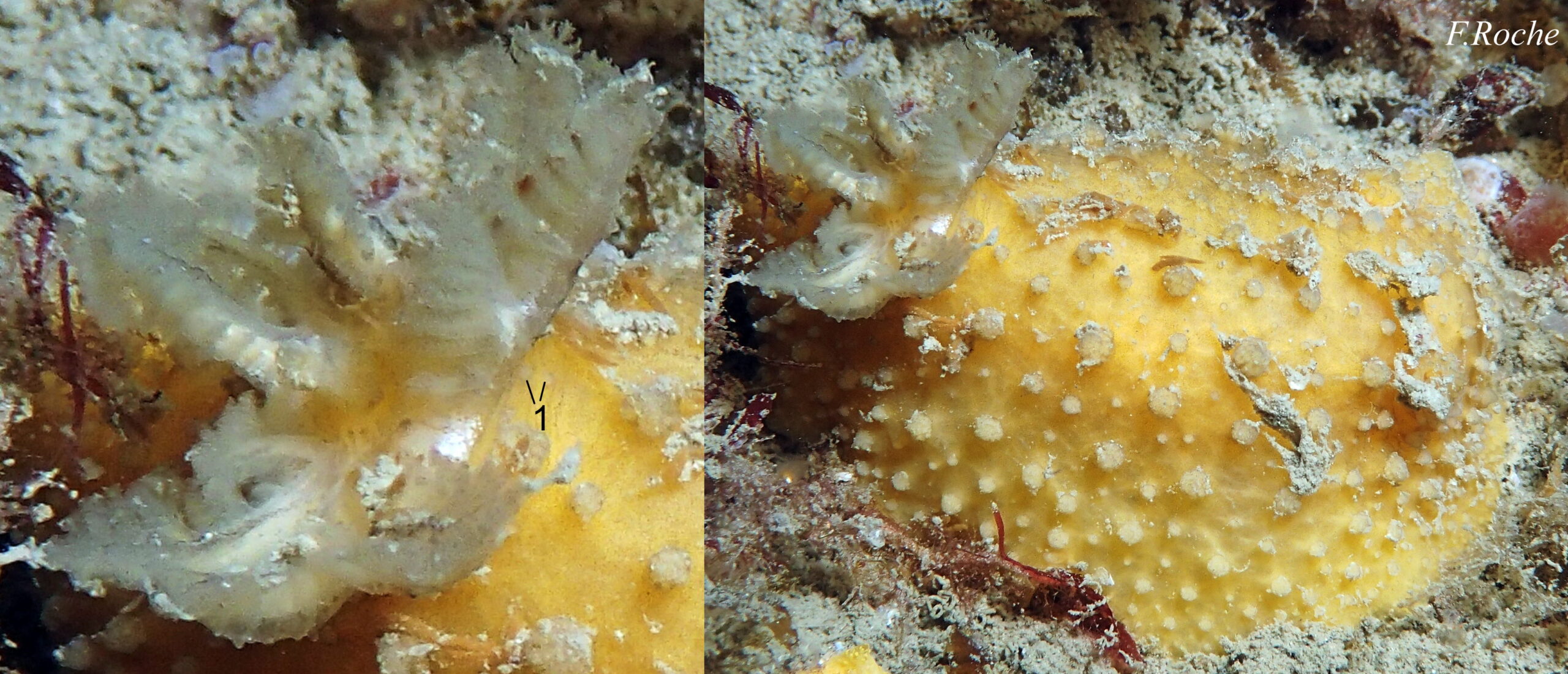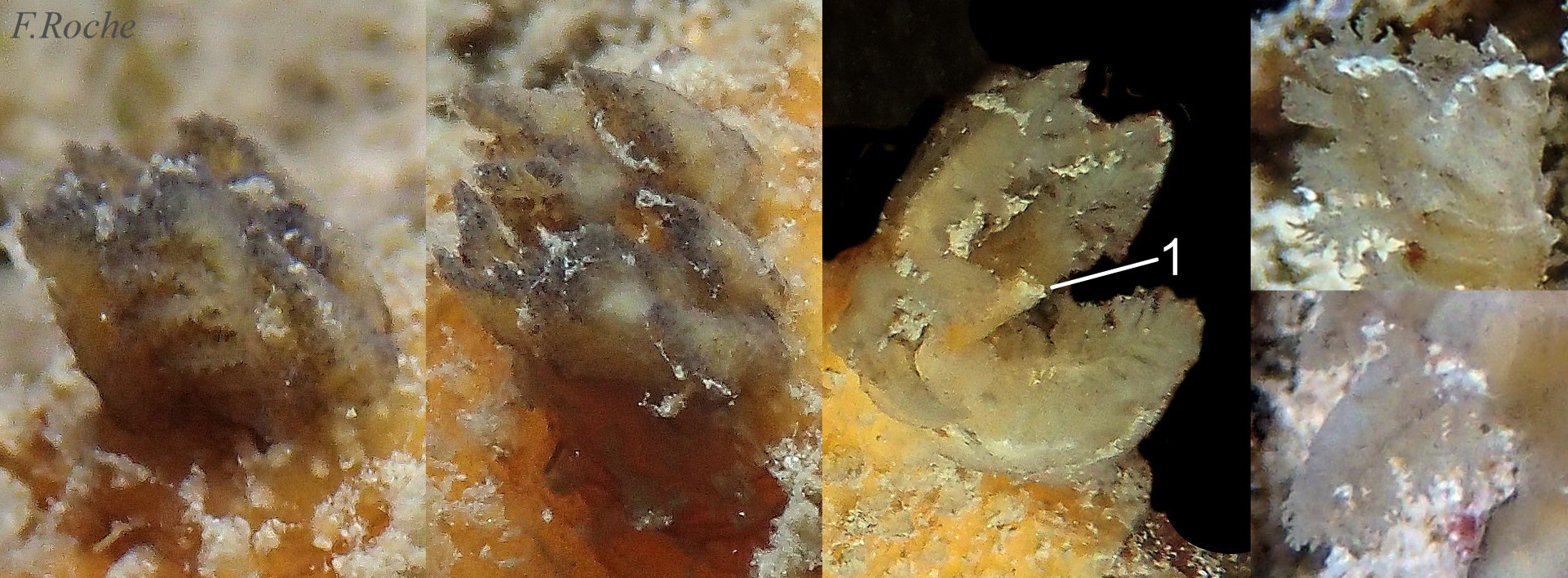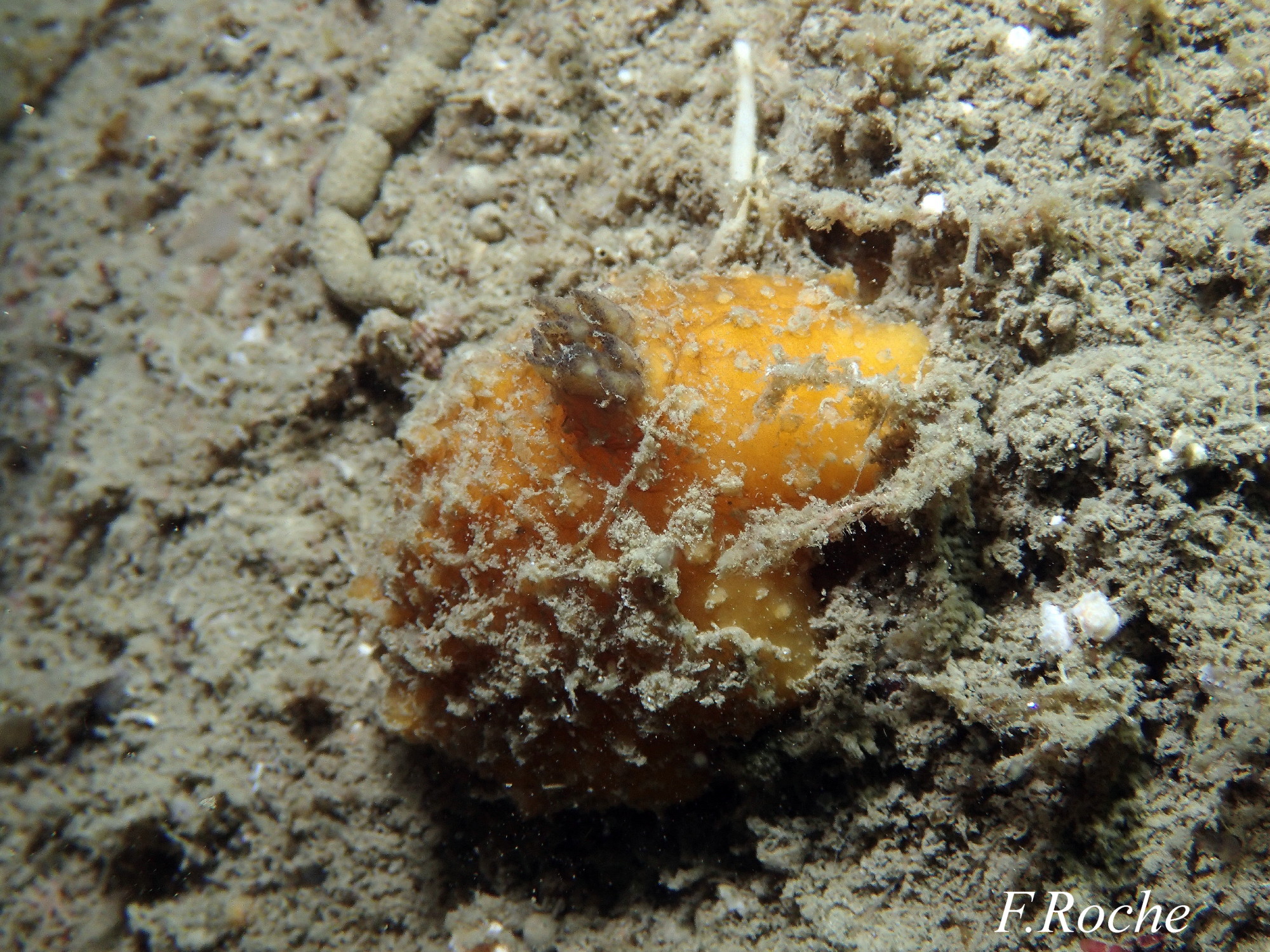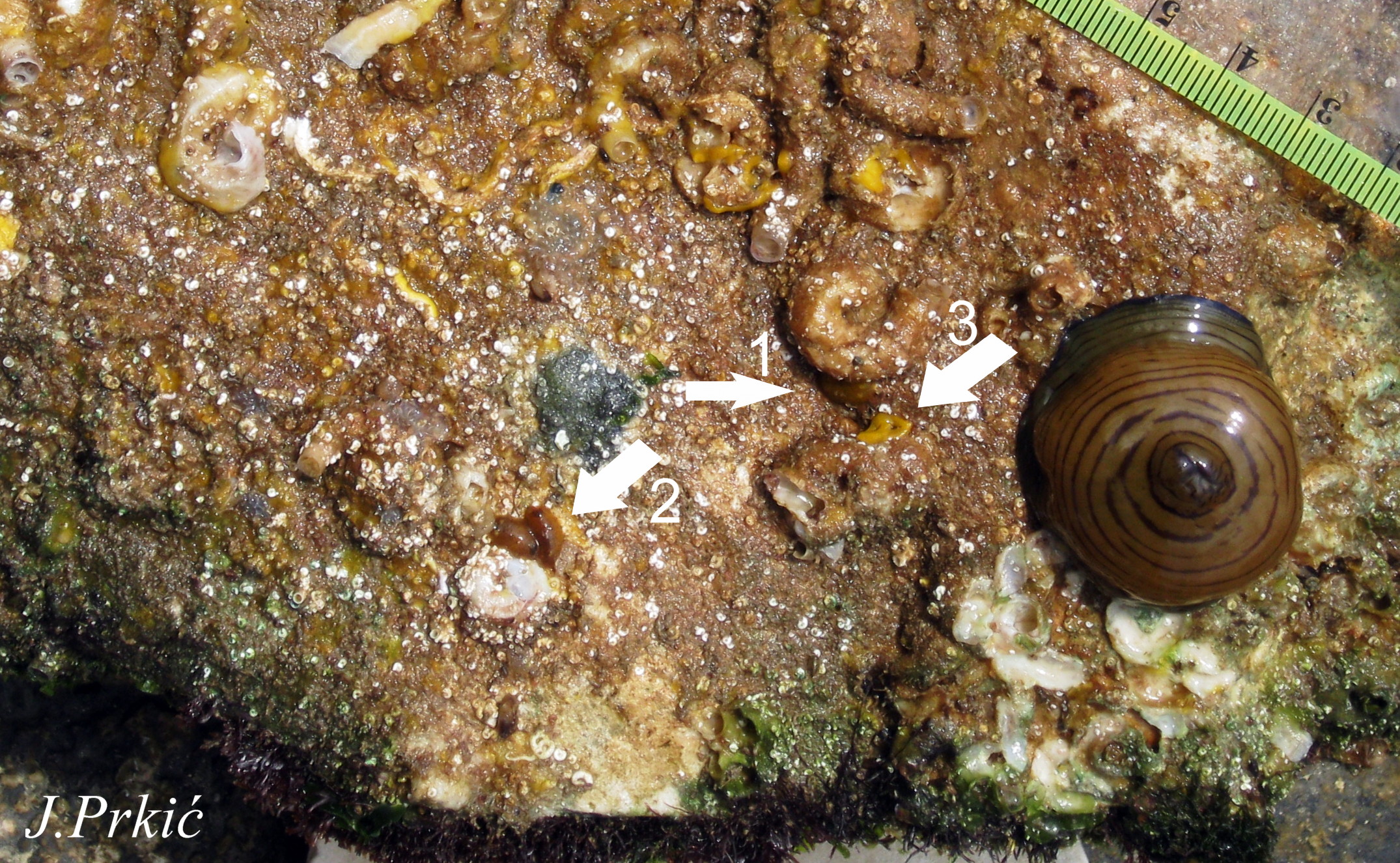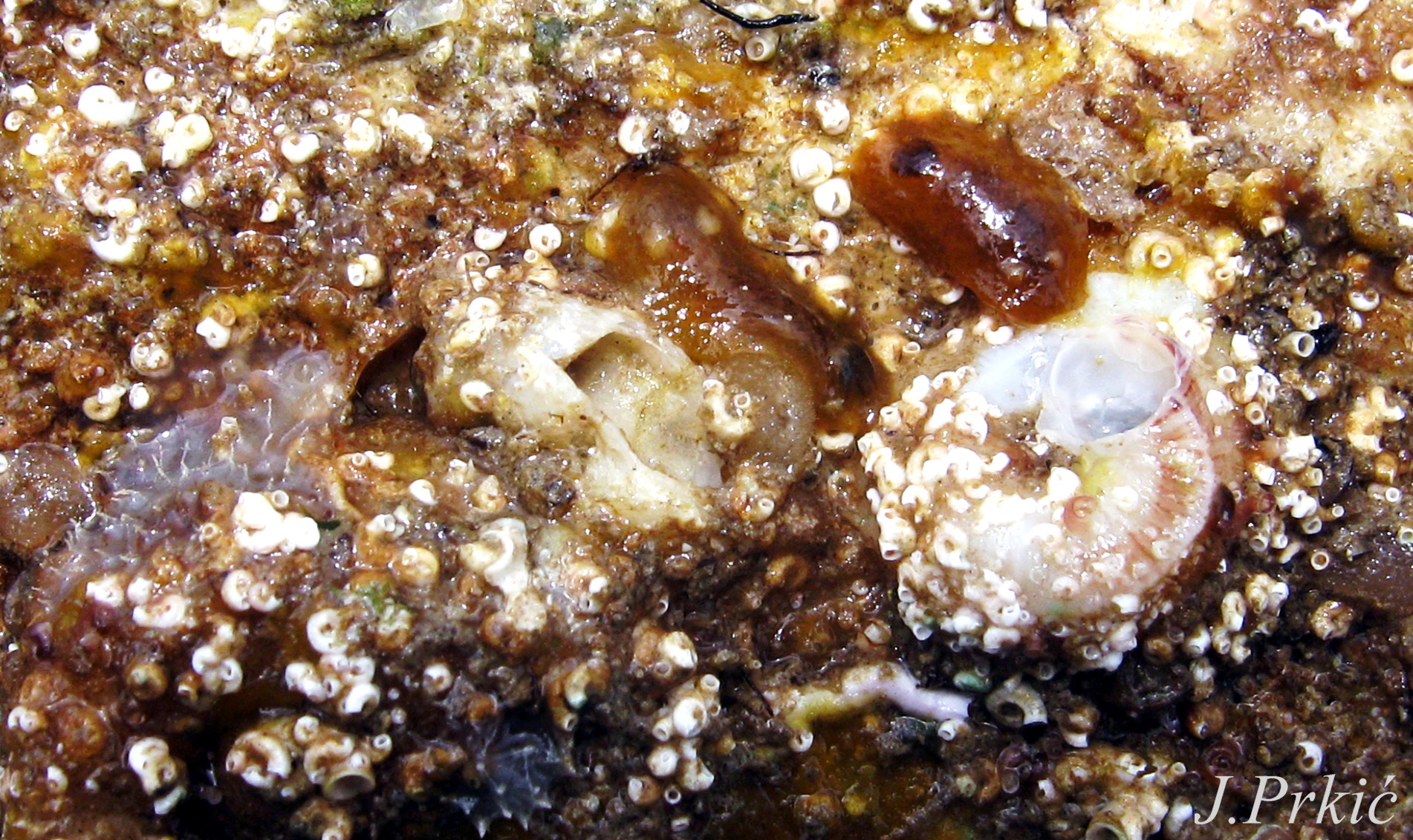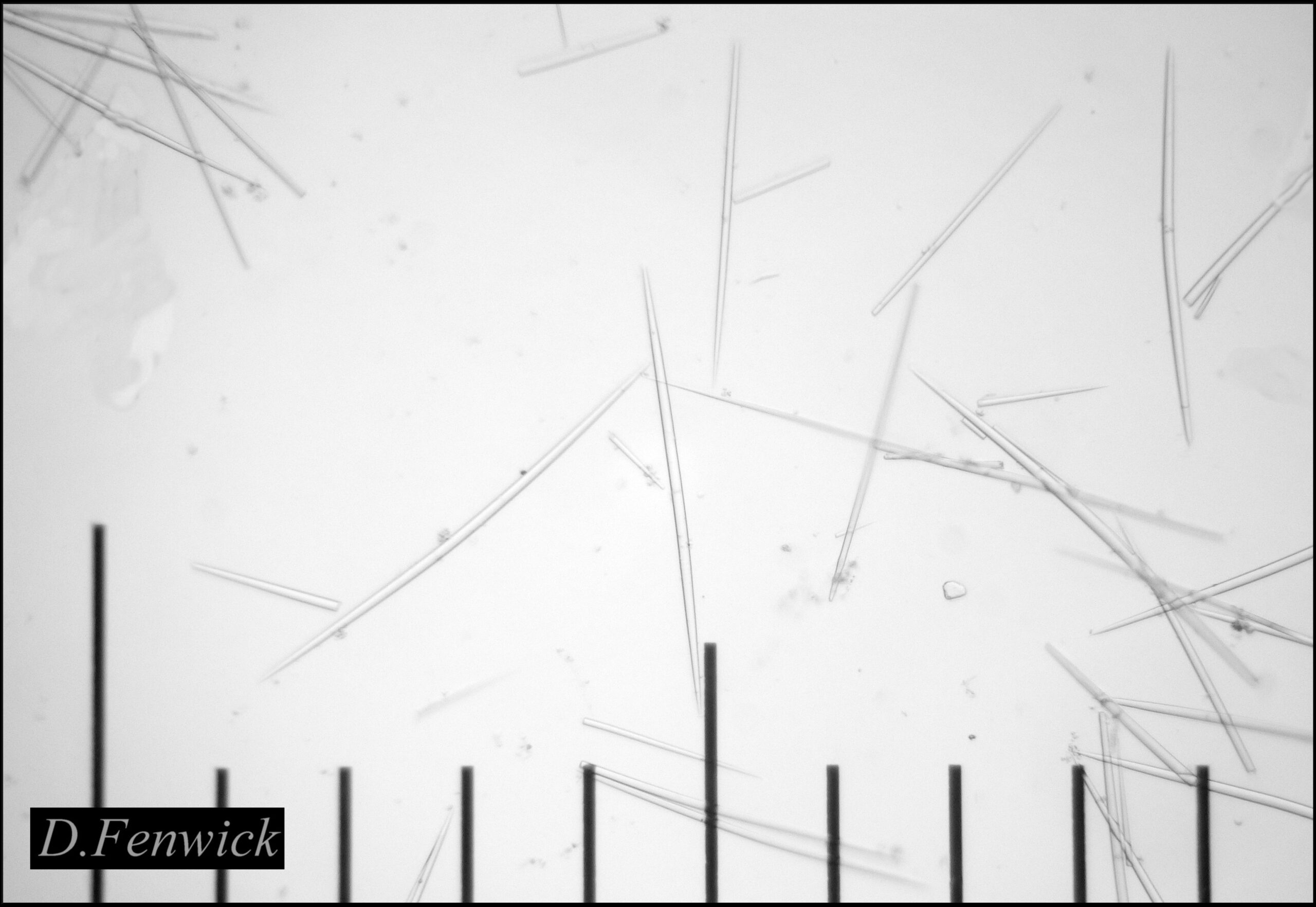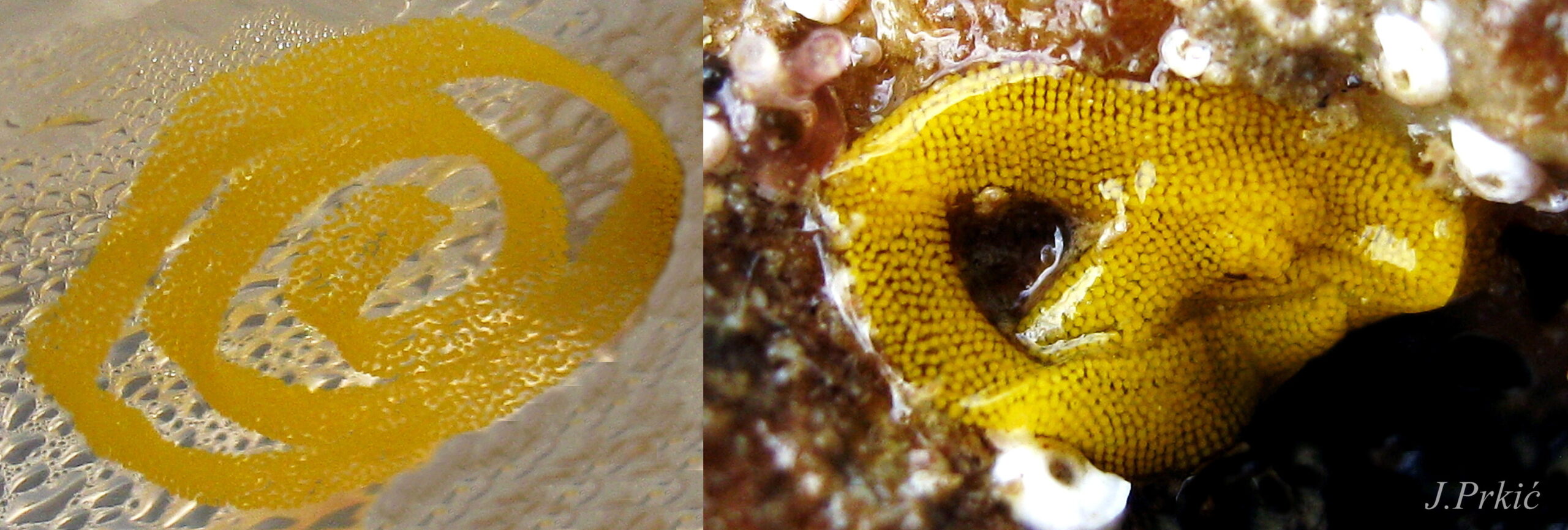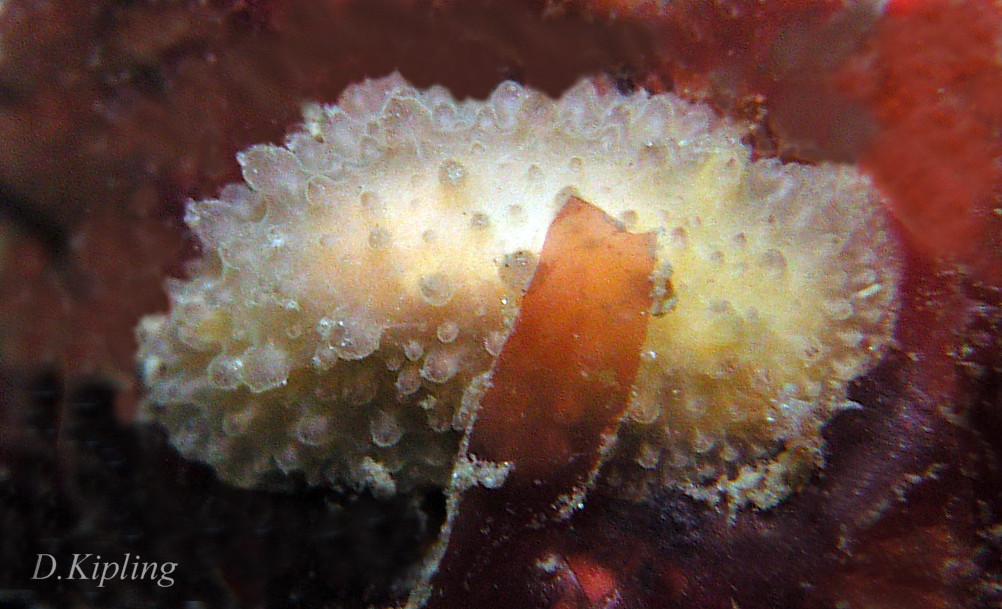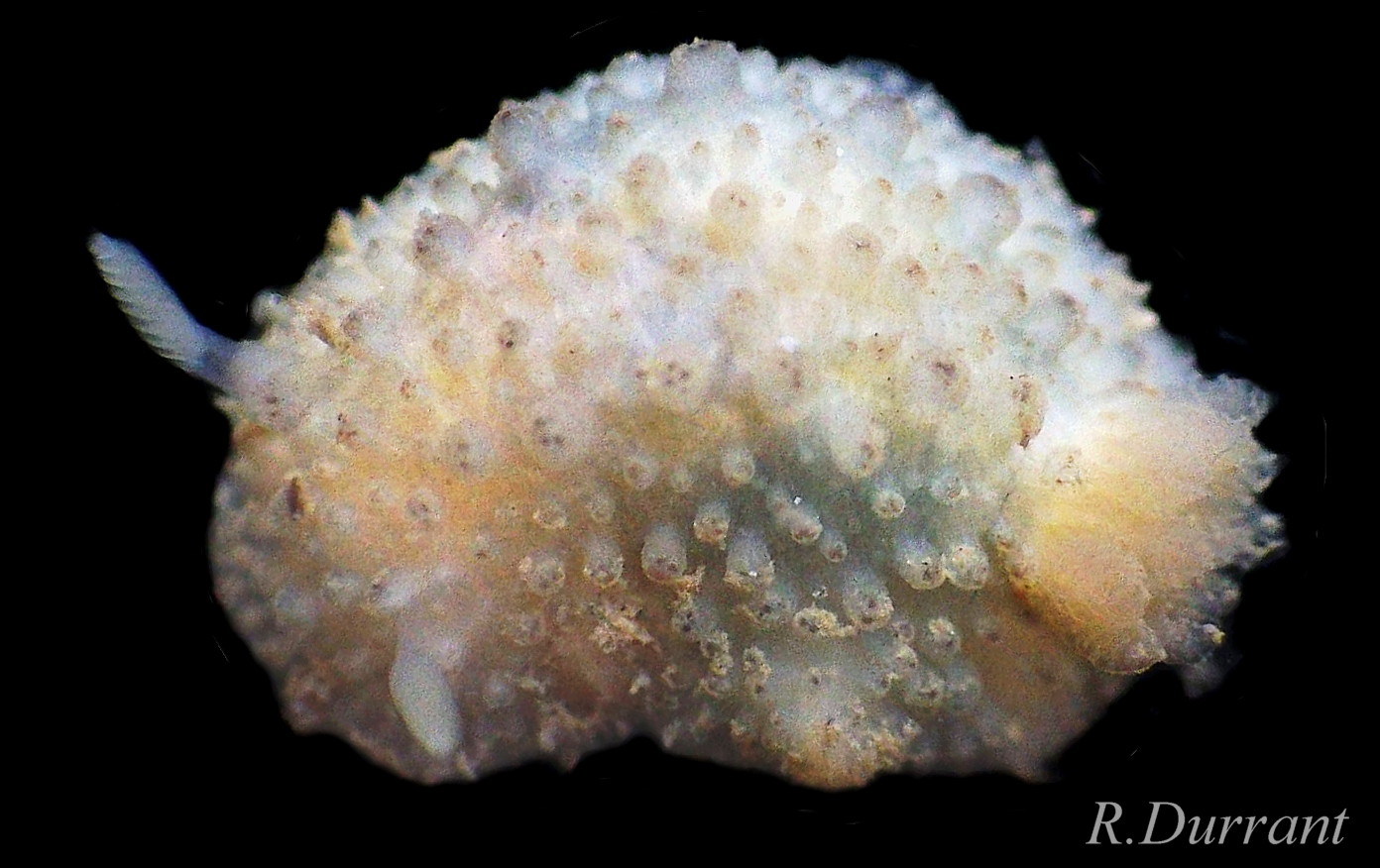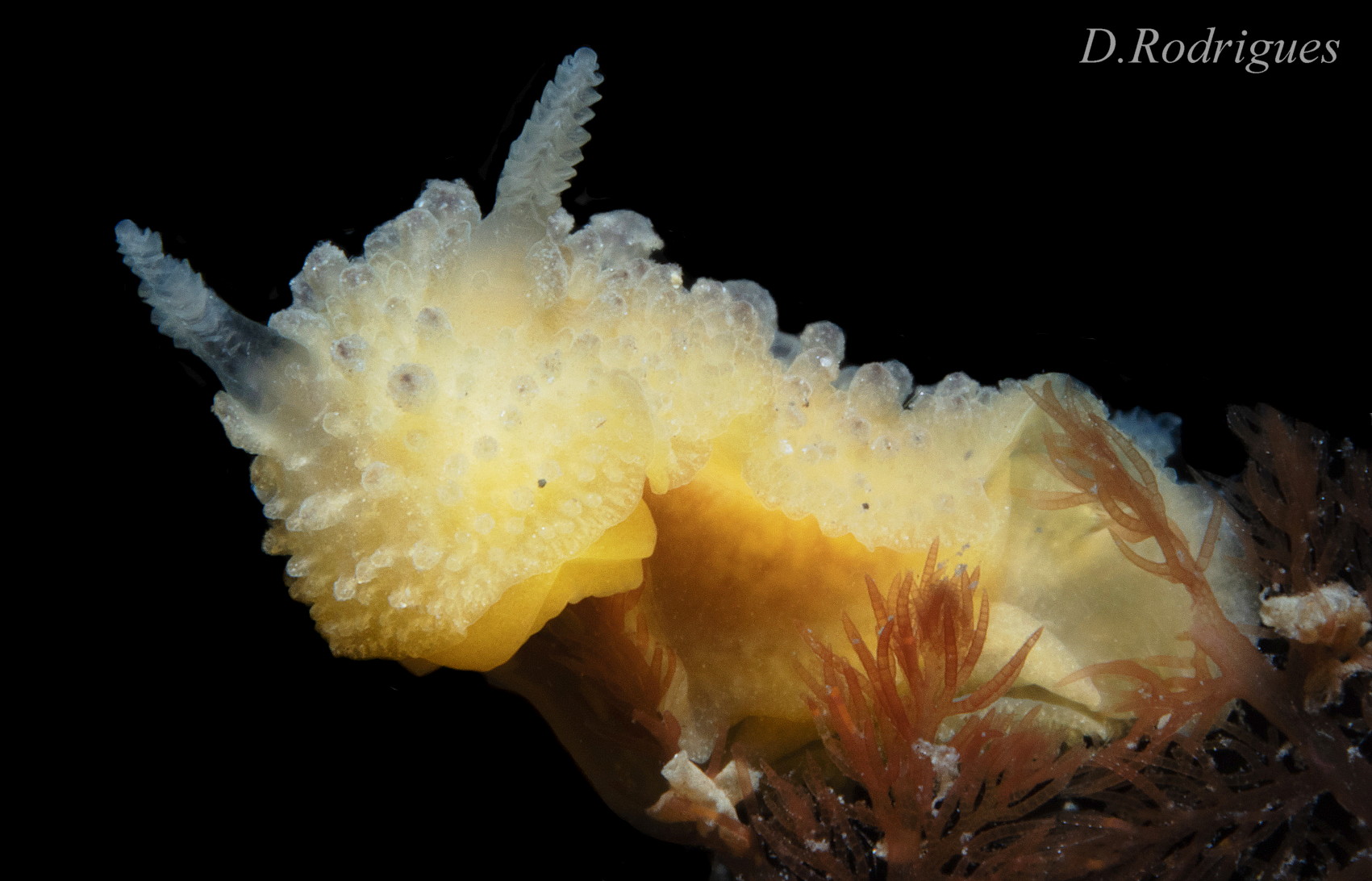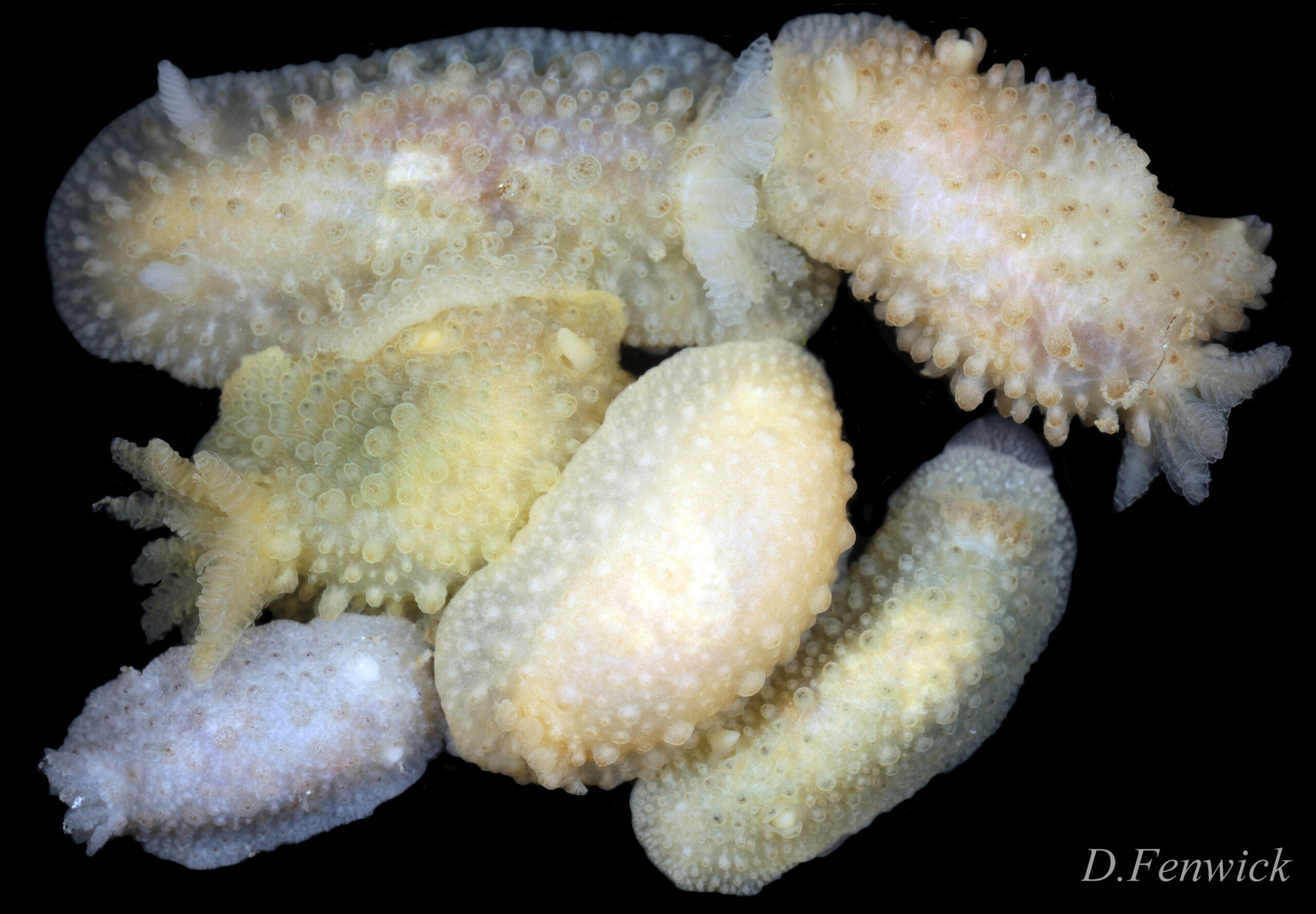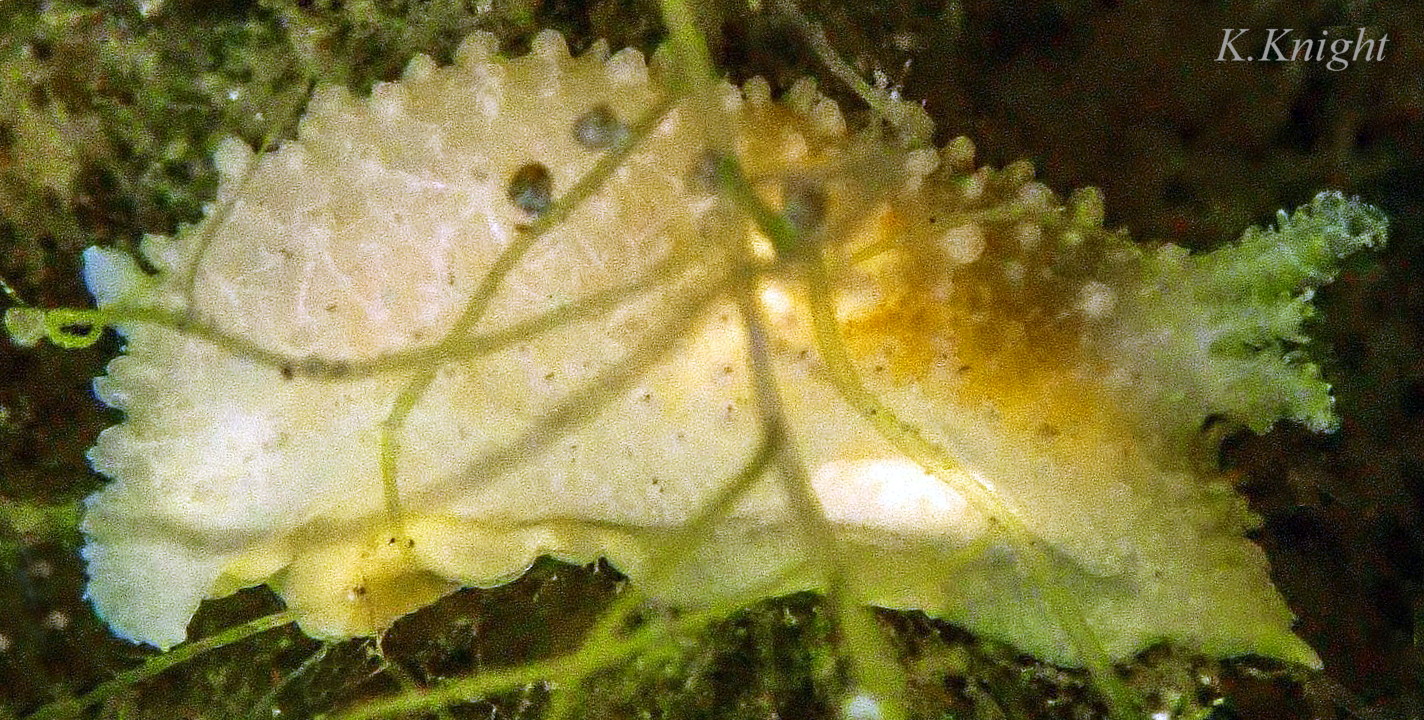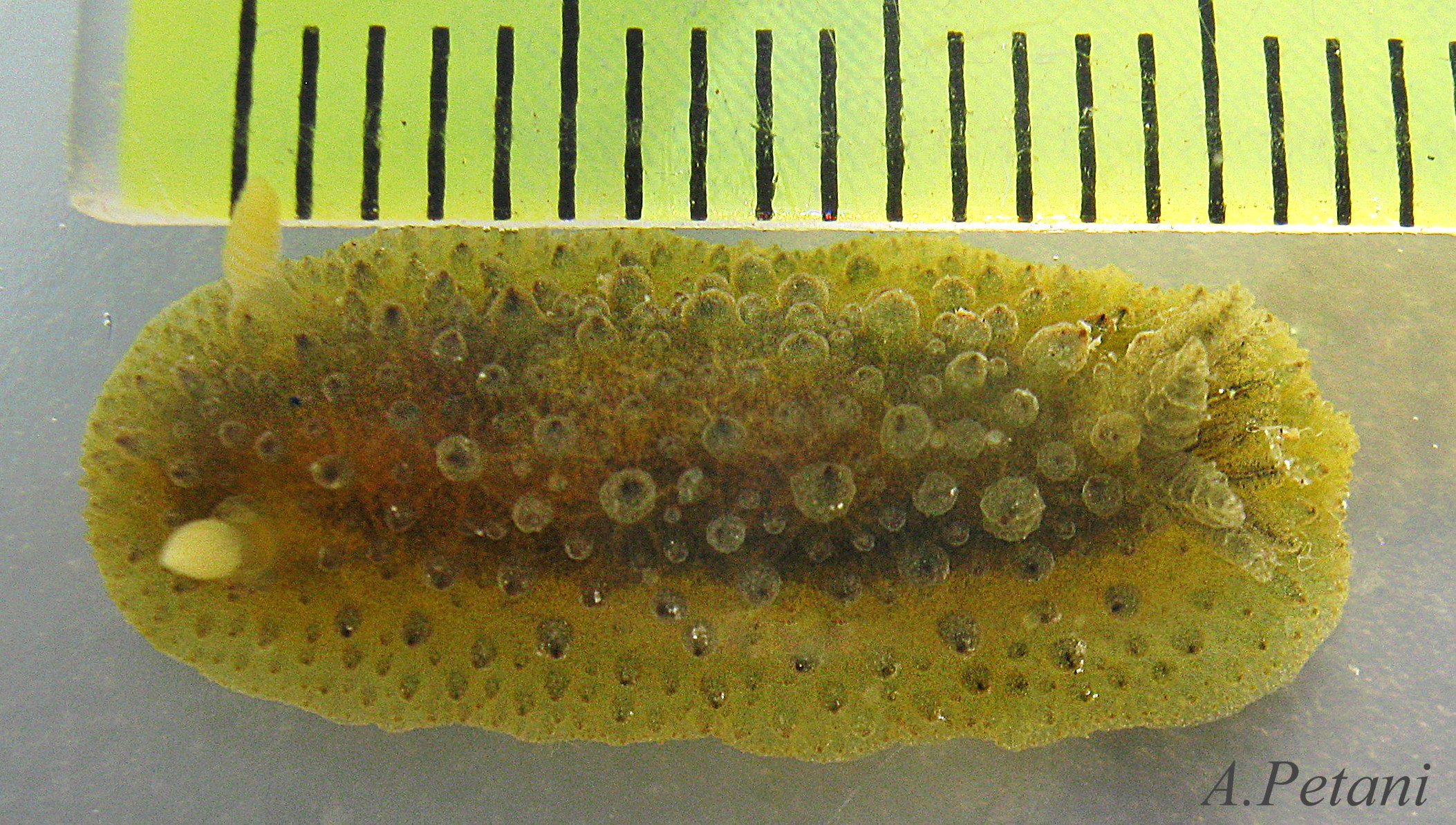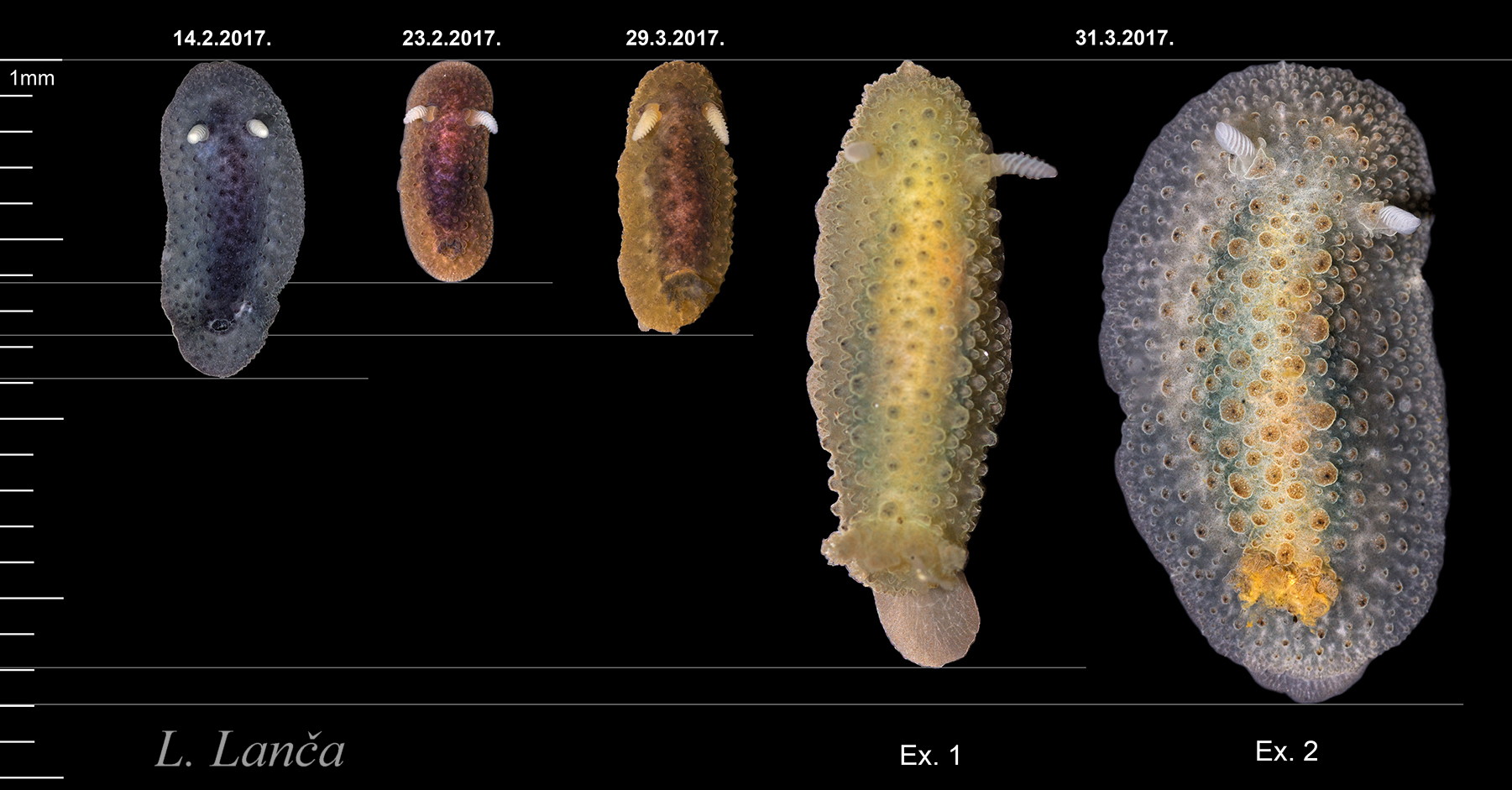Click image to enlarge with full caption. Main text below slider.
Doris ocelligera (Bergh, 1881)
Authors: Jakov Prkić (images & text) and Ian F. Smith (text).
PDF available at www.researchgate.net/publication/366988260_Doris_ocellige…
Synonyms: Staurodoris ocelligera Bergh, 1881; Aldisa berghi Vayssière, 1901.
Current taxonomy: World Register of Marine Species www.marinespecies.org/aphia.php?p=taxdetails&id=139620
GLOSSARY BELOW
Preface
This account is based on the original description of specimens from Trieste in Bergh (1881), Schmekel & Portmann (1982) and on detailed study by J.P. of over 100 specimens in Croatia at sites 130 to 300 km from Trieste.
Atlantic finds differ in some respects from those in the Mediterranean and are dealt with separately in the ‘Key Features’ section below. They may be a distinct Atlantic form or another species. Molecular sequencing is required to ascertain their relationship.
Description
Mature adults are usually 6 mm to 12 mm long, with 15 mm maximum. Individual length varies with extension; a 13 mm specimen can become 15 mm at extreme extension 01 Doris ocelligera . Very rarely a specimen is found with an extreme maximum length of 20 mm when extended 59 Doris ocelligera & 60 Doris ocelligera . Reports of 25 mm may be errors of estimation, identification or confusion. For example, the same image is shown as 25 mm at www.seaslugforum.net/find/doriocel and 15 mm at www.medslugs.de/E/Med/Doris_ocelligera/Doris_ocelligera_0… (accessed 16 December 2022).
The body varies from a depressed, very broad ellipse to a high, narrow, attenuated ellipse with almost parallel sides 02 Doris ocelligera . The mantle is usually a dull or dark shade of brown, green or ochre 03 Doris ocelligera but, occasionally, bright yellow, bright orange-yellow 04 Doris ocelligera , black-grey 05 Doris ocelligera or blue-grey 06 Doris ocelligera are locally common. Usually the notum is darkest at the centre, but occasionally there are darker dorsolateral bands 07 Doris ocelligera . The mantle often has fine black-brown specks 08 Doris ocelligera .
The mantle is covered by well-spaced, spiculose tubercles, variable in number and size with shape ranging from low rounded 09 Doris ocelligera to conical with obtuse tip 10 Doris ocelligera , but always widest at base. Often, some tubercles are inflated; the proportion varies from none 08 Doris ocelligera to almost all 07 Doris ocelligera . Those with many inflated tubercles (rare) could be confused with small D. verrucosa. The tubercles are usually darker than the mantle 01 Doris ocelligera and/or have a dark apical spot giving the mantle an ocellated appearance 11 Doris ocelligera . The number of tubercles with dark apices varies from very few 12 Doris ocelligera to almost all 11 Doris ocelligera . Tubercles lacking dark pigment may be concolorous with the mantle. Detritus often adheres to tubercles.
There are up to twenty short, irregularly arranged, spicules in large tubercles 13 Doris ocelligera . Seen under magnification in good light, some spicules may protrude from the tubercles 14 Doris ocelligera ; protrusion varies with the condition of the specimen. A few tubercle-spicules may be much longer than others. Long spicules in the mantle radiate from the base of tubercles and meet others, often giving a quilted appearance to the mantle 03 Doris ocelligera . Spicules are usually visible in the translucent underside of the mantle 15 Doris ocelligera .
The rhinophores have translucent pure-white 03 Doris ocelligera to yellowish-white 16 Doris ocelligera lamellae which strongly contrast with the frequently dull or dark mantle. There are two large spatulate guard-tubercles on the rim of the rhinophore pit 09 Doris ocelligera . They have a smooth inner face, and curved outer face, often with projecting spicules 14 Doris ocelligera . The rim of the rhinophore-pit is often raised into collar connecting the guard-tubercles and, sometimes, merging with and obscuring them 17 Doris ocelligera . The collar can sometimes extend into a tubular sheath 18 Doris ocelligera .
There are seven to ten lamellae on the distal two thirds of a fully extended rhinophore. The stem is smooth, transparent and colourless 19 Doris ocelligera , but very often appears tinted when the enclosing tubular sheath is translucent 11 Doris ocelligera & 20 Doris ocelligera . The stem is often retracted, leaving only the lamellae exposed 21 Doris ocelligera . When the entire rhinophore retracts, the guard-tubercles may close over it 14 Doris ocelligera .
The unipinnate gills10 Doris ocelligera are usually tilted backwards 09 Doris ocelligera ; there are nine or ten on adults 22 Doris ocelligera and six to eight on smaller individuals. The posterior gills are usually smaller than the anterior ones. They are translucent with fine black-brown specks. Their colour varies with the density and extent of the specks, from much darker than the mantle 09 Doris ocelligera to, occasionally, concolorous 12 Doris ocelligera or lighter 06 Doris ocelligera . Sometimes, there is a dark line on the main rib of each plume which meets others at the central anus 23 Doris ocelligera . The branchial pocket is surrounded by a collar carrying about one spatulate guard-tubercle per plume 24 Doris ocelligera ; often about half of the tubercles are noticeably larger than the others. When the gills retract, the collar with tubercles may extend upwards to form a sheath around them. The guard-tubercles have a flat, smooth, inner face and slightly rounded, spiculose, outer face.
The head has a very variable oral-lobe on each side of the mouth 25 Doris ocelligera . The lobes have a cavity distally, but it is often difficult to discern. The mouth is usually concealed in a groove between the oral lobes but, when everted, it is a large, thick-rimmed circle.
When in motion, the foot protrudes beyond the posterior edge of the mantle, and many long internal spicules are visible 26 Doris ocelligera . The anterior margin is bilaminate with no vertical notch 25 Doris ocelligera . The translucent sole is yellow to orange-yellow with no pigment marks, and it reveals grey-green, brown or bright yellow viscera and contrasts with the underside of dark mantles 27 Doris ocelligera . Occasionally, pale individuals have a yellowish-white sole with very distinct spicules 26 Doris ocelligera . The dorsal foot-surface is a similar colour to that of the sole but often also has darker speckles 18 Doris ocelligera .
Key identification features
All forms and similar species described below vary; difficult to determine variations and deviations may occur.
Doris ocelligera Mediterranean form.
A characteristic Mediterranean specimen is less than 16 mm long and has a dark opaque body with contrasting white rhinophores and dark gills. The tubercles are dark, broad-based domes or cones, frequently with a dark apical spot.
1) The rhinophores have translucent pure-white 03 Doris ocelligera to yellowish-white 16 Doris ocelligera lamellae which strongly contrast with the frequently dull or dark mantle.
2) Tubercles vary in number and size with shape ranging from low rounded 09 Doris ocelligera to conical with obtuse tip 10 Doris ocelligera , but always widest at base. They are often much darker than the mantle and/or have a dark apical spot 11 Doris ocelligera .
3) Spawn, canary-yellow, not undulated, ribbon in loose coil of less than three turns 53 Doris ocelligera , diameter usually under 10 mm.
4) Large range of mantle colours: usually a dull or dark shade of brown, green or yellow 03 Doris ocelligera , but occasionally bright yellow, bright orange-yellow 04 Doris ocelligera , black-grey 05 Doris ocelligera or blue-grey 06 Doris ocelligera . Not usually translucent. Mantle often has a quilted appearance.
5) Mature adults usually 6 mm to 12 mm long, usual maximum 15 mm, very rarely 20 mm at extreme extension,.
6) Seen under magnification in good light, some spicules can be seen protruding from tubercles 14 Doris ocelligera .
7) Tubercles sometimes dark. Dark apical spot on most specimens.
8) Two large spiculose, spatulate guard-tubercles on rim of rhinophore pit 09 Doris ocelligera .
9) Up to ten spiculose, spatulate guard-tubercles at base of gill 24 Doris ocelligera .
10) Up to ten unipinnate gills 10 Doris ocelligera , often much darker than mantle.
11) No linear oral tentacles, but very variable oral-lobe on each side of mouth 25 Doris ocelligera Flickr . Lobe has cavity distally, but often difficult to discern.
12) Precise range limits uncertain; it may extend into the Atlantic in Iberia or intergrade there with the Atlantic form.
Doris cf. ocelligera from north-west European Atlantic.
Features 1 to 4 in particular usually differ from Mediterranean D. ocelligera.
A characteristic Atlantic specimen is less than 16 mm long and has a pale translucent body with concolorous rhinophores and gills. The tubercles are roughly columnar or narrowed at the base and are concolorous with the mantle except for a frequent dark apical spot.
1) Rhinophores concolorous with pale mantle 28 Doris cf. ocelligera & 29 Doris cf. ocelligera .
2) Tubercles distally irregular, almost columnar or with narrower base 28 Doris cf. ocelligera & 30 Doris cf. ocelligera not a broad based dome .
3) Spawn a whitish or yellowish white, undulating ribbon in a coil of less than three complete turns 31 Doris cf. ocelligera .
4) Small range 57 Doris cf. ocelligera of pale mantle colours between white 28 Doris cf. ocelligera and yellowish 29 Doris cf. ocelligera ; often very translucent showing viscera 32 Doris cf. ocelligera . But occasional exceptions 33 Doris cf. ocelligera & 34 Doris cf. ocelligera .
5) Maximum length uncertain, 7 mm to 15 mm on available images. Some divers’ estimates of 20 mm.
6) Detritus frequently catches on tubercles; may be because of projecting spicules 28 Doris cf. ocelligera & 34 Doris cf. ocelligera .
7) Tubercles concolorous with mantle and often have a dark apical spot 29 Doris cf. ocelligera & 30 Doris cf. ocelligera .
8) Guard-tubercles present at base of rhinophores 30 Doris cf. ocelligera & 32 Doris cf. ocelligera but no extended sheath observed.
9) Spatulate guard-tubercles at base of gills 30 Doris cf. ocelligera .
10) Up to nine unipinnate gills, concolorous with mantle or paler 28 Doris cf. ocelligera ; rare exceptions may have orange gills when mantle white 34 Doris cf. ocelligera .
11) [No images of head available].
12) Precise range limits uncertain; it may extend into the Mediterranean or intergrade in Iberia with the Mediterranean form.
Similar species
Doris verrucosa Linnaeus, 1758.
The large size of adult D. verrucosa, to 70 mm, immediately distinguishes it from both forms of D. ocelligera with usual maximum length 15 mm. No specimens or web image of D.verrucosa under 20 mm length have been knowingly viewed, so it is uncertain if the features below apply to juveniles shorter than 15 mm.
1) Rhinophores concolorous with mantle 35 Doris ocelligera COMPARE Doris verrucosa & 39 Doris ocelligera COMPARE Doris verrucosa , or nearly so. Sometimes flecked with fine brown spots 36 Doris ocelligera COMPARE Doris verrucosa . Stem swollen when not fully extended, but form a continuous cone with the distal lamellate section when fully extended 42 Doris ocelligera COMPARE Doris verrucosa .
2) Tubercles, vary from very small to very large and swollen with narrow bases 37 Doris ocelligera COMPARE Doris verrucosa .
3) Spawn is a white or yellow undulated ribbon deposited in a spiral 38 Doris ocelligera COMPARE Doris verrucosa . Diameter usually over 20 mm.
4) Ground colour of mantle usually whitish, yellow 39 Doris ocelligera COMPARE Doris verrucosa , orange-brown 40 Doris ocelligera COMPARE Doris verrucosa , light violet, or greyish, sometimes with dark dorso-lateral bands 41 Doris ocelligera COMPARE Doris verrucosa .
5) Adult length often 40 mm, up to 70mm.
6) Tubercles smooth without protruding spicules, but adhering detritus may give rough appearance 42 Doris ocelligera COMPARE Doris verrucosa .
7) Tubercles concolorous with mantle 39 Doris ocelligera COMPARE Doris verrucosa & 43 Doris ocelligera COMPARE Doris verrucosa or a slightly darker shade 37 Doris ocelligera COMPARE Doris verrucosa , occasionally darkened apically 40 Doris ocelligera COMPARE Doris verrucosa .
8) Two smooth large spatulate guard-tubercles on rim of rhinophore pit 35 Doris ocelligera COMPARE Doris verrucosa .
9) Gills protected by spatulate guard-tubercles 41 Doris ocelligera COMPARE Doris verrucosa & 43 Doris ocelligera COMPARE Doris verrucosa .
10) Gills unipinnate and concolorous with 39 Doris ocelligera COMPARE Doris verrucosa , or nearly so 41 Doris ocelligera COMPARE Doris verrucosa or darker than the mantle.
11) Head has short, grooved oral tentacles (Thompson and Brown 1984).
12) Occurs in the Mediterranean and Atlantic coast north to Brittany. A few uncertain reports from south coast England.
Doris adrianae Urgorri & Señarís, 2021. 44 Doris ocelligera COMPARE Doris adrianae
The large size of adult D. adrianae , to 76 mm long, immediately distinguishes it from both forms of D. ocelligera with usual maximum length 15 mm. It is more likely to be confused with D. verrucosa.
1) Rhinophores concolorous with mantle.
2) Tubercles are low domes of various sizes but not greatly inflated 44 Doris ocelligera COMPARE Doris adrianae .
3) Spawn is a slightly greyish, hyaline white, undulating, 5 mm-wide ribbon with a brown upper edge. It is deposited as a spiral of two to two and a half turns.
4) Mantle yellow to orange-yellow.
5) Adult often 40 mm to 55 mm long and 30 mm to 40 mm wide.
6) Tubercles have nodose surface, resembling cauliflower 45 Doris ocelligera COMPARE Doris adrianae . Lattice of radiating spicules within tubercles may be visible, but do not protrude; animal feels very stiff.
7) Tubercles concolorous with mantle, no dark apical mark.
8) Rhinophores have tall sheaths with very small tubercles on their surface, but no spatulate guard-tubercles 45 Doris ocelligera COMPARE Doris adrianae .
9) Gills surrounded at their base by sheath with very small tubercles on its surface, but no spatulate guard-tubercles 46 Doris ocelligera COMPARE Doris adrianae .
10) Gills translucent whitish with opaque white and dark marks 46 Doris ocelligera COMPARE Doris adrianae . Tripinnate with wide ragged pinnae; arranged around tall, tubular anal papilla 47 Doris ocelligera COMPARE Doris adrianae .
11) Head has two lateral oral lobes.
12) First described in 2021 from Galicia, north-west Spain. Also from Portugal and on mud among detritus at 30 to 40 m depth in Bretagne, France fig 48 48 Doris ocelligera COMPARE Doris adrianae . As only recently recognised it may be more widespread.
Habits and ecology
Both forms of D. ocelligera sensu lato are found under intertidal stones 49 Doris ocelligera and sublittorally, to about 25 m depth in the Mediterranean. The diet is uncertain and may vary geographically. In Croatia, it probably feeds on the early growth stages of various sponge species, including a membranous canary-yellow species sometimes found adhering to underside of rocks with D. ocelligera50 Doris ocelligera .
In Cornwall, faeces of D. cf. ocelligera contain sponge-spicules, possibly of a Halichondria species 51 Doris cf. ocelligera .
Like other nudibranchs, both forms are simultaneous hermaphrodites.
D. ocelligera in Croatia, when 6 mm and longer, breed from June to October and in January 52 Doris ocelligera . Canary-yellow, not-undulated, ribbons of spawn are attached by the edge in a loose coil of up to about two and a half turns 53 Doris ocelligera , diameter 3 to 8 mm, rarely to 20 mm with three turns if laid by an unusually big individual. The ova may be arranged in the ribbon in distinct transverse lines of about 15 ova each, but may become disordered.
D. cf. ocelligera in north-west Europe deposit whitish or yellowish white, undulating ribbons of spawn in a coil in July 31 Doris cf. ocelligera and probably in other summer months.
Distribution and status
D. ocelligera sensu stricto lives in the Mediterranean including the Adriatic and the North African coast.
Specimens recorded in the Atlantic 32 Doris cf. ocelligera , D. cf. ocelligera, may be a different species. It was first recorded in Britain in 2003 in southern Cornwall 54 Doris cf. ocelligera and 2004 in Dorset (Rudman, 2009). Since then, it has been recorded over sixty times as far as Dorset and North Devon 55 Doris cf. ocelligera , and several have been found on the west of Ireland 56 Doris cf. ocelligera and, in 2020, one in Skye, Scotland 58 Doris cf ocelligera NBN map species.nbnatlas.org/species/NHMSYS0021056225 (accessed 21 December 2022). It is locally common; over 30 being found at a time in Cornwall 57 Doris cf. ocelligera (D. Fenwick, pers. comm., 21 December 2022). Since 2020, several have been recorded from the Oosterschelde estuary in the Netherlands GBIF map www.gbif.org/species/5724728 .
Acknowledgements
The images in this account are by author Jakov Prkić and the following photographers whom we gratefully thank: Glenn Biscop, Sarah Bowen, Pierre Corbrion, Robert Durrant, David Fenwick, David Kipling, Katherine Knight, Leo Lanča, Paolo Mariottini, Alen Petani, Siôn Roberts, François Roche, Daniel Rodrigues, João Pedro Silva, Stefan Verheyen and Carla van Westing.
References and links
Bergh L.S.R. 1881. Malacologische Untersuchungen, in: Semper, C.G., 1887. Reisen im Archipel der Philippinen. pp 79-128. Wiesbaden, Germany.
As Staurodoris ocelligera pp. 95-98 www.biodiversitylibrary.org/item/50267#page/133/mode/1up
& plate H fig.11-21 (internal anatomy) archive.org/details/malacologischeun04berg/page/n359/mode…
Fenwick, D. (accessed December 2022) Aphotomarine, images of marine molluscs. www.aphotomarine.com/
Koehler, E. Sea slugs of the Mediterranean Sea and elsewhere. www.medslugs.de/E/Med/select.htm
Prkić, J., Petani, A., Iglić, Đ. and Lanča, L. 2018. Opisthobranchs of the Adriatic Sea. Photographic atlas and list of Croatian Species. Croatia.
Rudman, W.B. 2006 Doris ocelligera (Bergh, 1881). [In] Sea Slug Forum. Australian Museum, Sydney. www.seaslugforum.net/factsheet/doriocel [Includes Mediterranean and Atlantic forms/species and confused maximum length; see description above].
Rudman, W.B. 2009 (Aug 21). Comment on first sighting of Doris ocelligera in the UK by David Kipling. [Message in] Sea Slug Forum. Australian Museum, Sydney. www.seaslugforum.net/find/22611
Schmekel, L. & Portmann, A. 1982. Opisthobranchia des Mittelmeeres. Berlin- Heidelberg. www.seaslugforum.net/find/22611
Urgorri, V., Señarís, M.P., Díaz-Agras, G., Candás, M. & Gómez-Rodríguez, C. 2021. Doris adrianae sp. nov. (Heterobranchia; Nudibranchia; Doridina) from the Galician coasts (NW Iberian Peninsula). Nova Acta Científica Compostelana (Bioloxía) 28: 1-33.
www.researchgate.net/publication/350290829_Doris_adrianae…
Glossary
cephalic = (adj.) of or on the head.
cf. = abbreviation of ‘confer’, Latin for ‘compare’, inserted into name when resemblance indicates a possible but uncertain identity.
dorid = a sea slug in the infraorder Doridoidei; usually with gills and rhinophores on the dorsum; often shaped like half a lemon or grape.
dorsolateral = at or near junction/merging of dorsal and lateral surfaces.
hermaphrodite, simultaneous = individual acts as both male and female at the same time with similar partner(s).
lamellae = (sing. lamella) small plates on rhinophores, or leaflets of gill.
mantle = (of sea slugs) sheet of tissue forming part or all of notum.
notum = dorsal body surface.
nudibranch = seaslugs in the order Nudibranchia with no shell when adult.
ocellated = having eye-like markings.
pinna = (pl. pinnae) primary element/leaflet of a pinnate gill, leaf, feather etc.
plankton = animals and plants that drift in pelagic zone (main body of water).
rhinophores (pl.) = chemo-receptor tentacles on top of head of nudibranch.
sensu lato = (abbreviation s.l.) in the wide sense, possibly an aggregate of more than one species.
sensu stricto = (abbreviation s.s.) in the strict sense, excluding species that have been aggregated or confused with it.
spicule (in dorid seaslugs) = small, slender, sharp-pointed feature mainly composed of calcite (CaCO3) and brucite (Mg(OH)2) .
tripinnate = (of gill plume) threefold branching; “boughs, branches, twigs” in one plane like a feather.
unipinnate = (of gill plume) branching singly; boughs but no subsequent branches or twigs, in one plane like a feather.
veliger = shelled larva of marine gastropod or bivalve mollusc which swims by beating cilia of a velum (bilobed flap).

